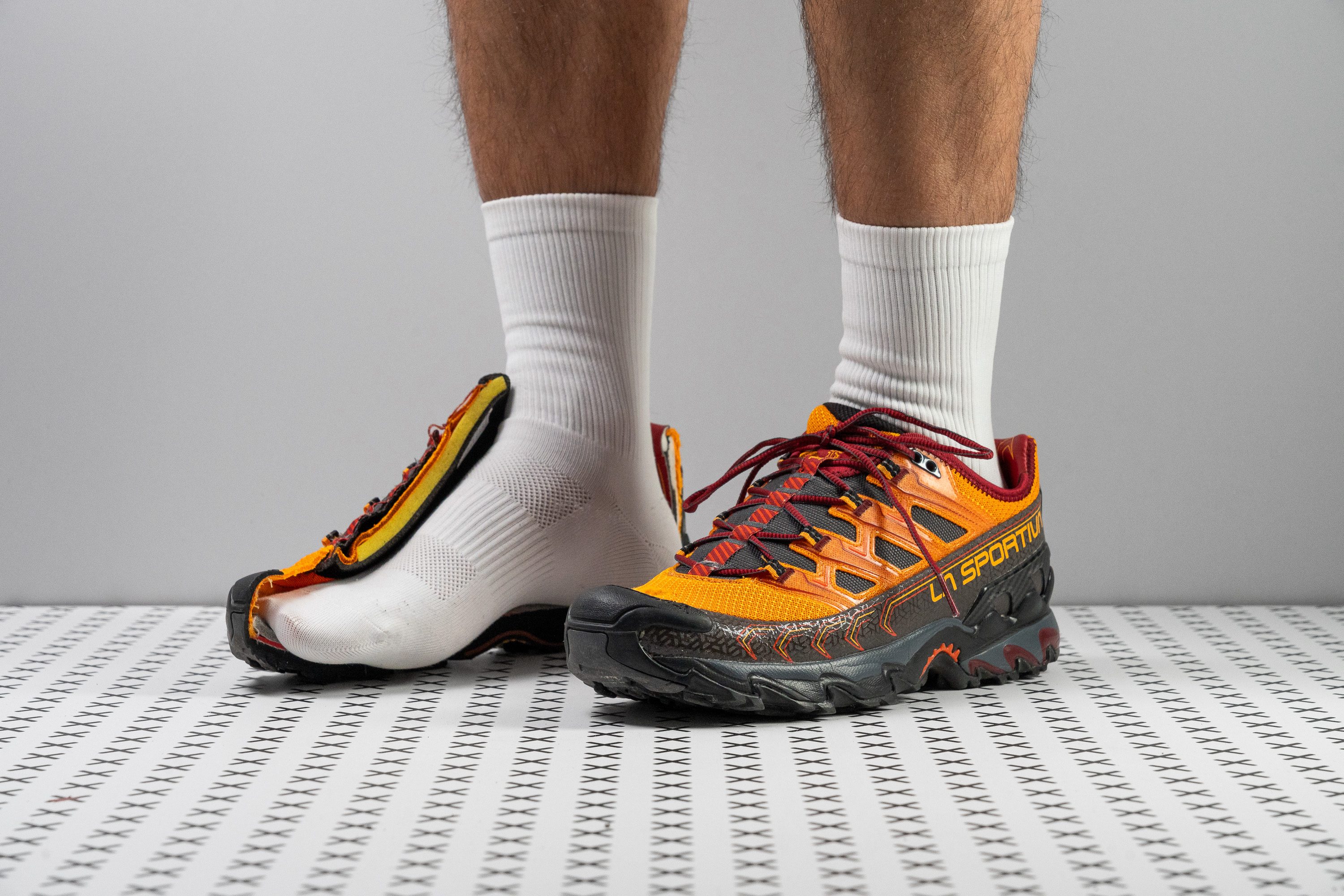Our verdict
- Top pick in best hiking shoes
Pros
- Superlative grip for technical terrain
- Excellent support and stability
- Solid foot protection
- Reasonable weight
- Decent breathability
- Smoother ride thanks to toe spring
- Flexible forefoot
Cons
- Outsole lacks durability (for the price)
- Very narrow fit (but available in wide)
- Quite expensive
Audience verdict
- Top 9% in hiking shoes
- Top 9% in lightweight hiking shoes
Comparison
The most similar hiking shoes compared
+ + Add a shoe | |||||
|---|---|---|---|---|---|
| Audience score | 90 Superb! | 79 Good! | 72 Decent! | 89 Great! | |
| Price | $205 | $100 | $135 | $120 | |
| Trail terrain | ModerateTechnical | ModerateTechnical | Moderate | Technical | |
| Weight lab Weight brand | 12.7 oz / 359g 12.5 oz / 355g | 13.4 oz / 380g 13.4 oz / 380g | 13.5 oz / 383g 12.8 oz / 363g | 15.3 oz / 434g 16.2 oz / 460g | |
| Lightweight | ✓ | ✓ | ✓ | ✗ | |
| Breathability | Moderate | Warm | Moderate | Breathable | |
| Use | Day Hiking | Day HikingBeginners | Day Hiking | Day HikingBeginners | |
| Orthotic friendly | ✓ | ✓ | ✓ | ✓ | |
| Drop lab | 10.6 mm | 14.0 mm | 10.2 mm | 11.2 mm | |
| Size | Half size small | True to size | - | True to size | |
| Midsole softness | Balanced | Firm | Firm | Firm | |
| Difference in midsole softness in cold | Normal | Small | Normal | Normal | |
| Torsional rigidity | Stiff | Moderate | Stiff | Moderate | |
| Heel counter stiffness | Flexible | Flexible | Moderate | Flexible | |
| Stiffness | Flexible | Flexible | Flexible | Flexible | |
| Difference in stiffness in cold | - | Small | - | Normal | |
| Outsole hardness | Average | Hard | - | Average | |
| Material | Mesh | MeshSuede | - | LeatherMesh | |
| Season | All seasons | Winter | All seasons | All seasons | |
| Toebox durability | Bad | Very good | Good | - | |
| Heel padding durability | Decent | Bad | Bad | - | |
| Outsole durability | Decent | Decent | Decent | - | |
| Width / fit | Narrow | Wide | Medium | Medium | |
| Toebox width | Narrow | Medium | Medium | Medium | |
| Lug depth | 4.4 mm | 4.0 mm | 4.5 mm | 4.8 mm | |
| Heel stack lab | 32.7 mm | 30.6 mm | 29.1 mm | 31.7 mm | |
| Forefoot | 22.1 mm | 16.6 mm | 18.9 mm | 20.5 mm | |
| Widths available | NormalWide | Normal | Normal | NormalWide | |
| Technology | Gore-TexOrtholite | - | Ortholite | Vibram | |
| Heel tab | None | Finger loop | Finger loop | Finger loop | |
| Removable insole | ✓ | ✓ | ✓ | ✓ | |
| Ranking | #3 Top 9% | #30 Bottom 14% | #34 Bottom 2% | #7 Top 20% | |
| Popularity | #13 Top 38% | #30 Bottom 14% | #15 Top 43% | #1 Top 3% |
Who should buy
We think that the Ultra Raptor II is worth your attention if:
- you need a highly capable mountain shoe with unmatched grip
- you mostly hike in dry and warm weather and above the treeline
- you want a reinforced shoe with great protection against rocks
- you prefer slim-fitting hiking shoes
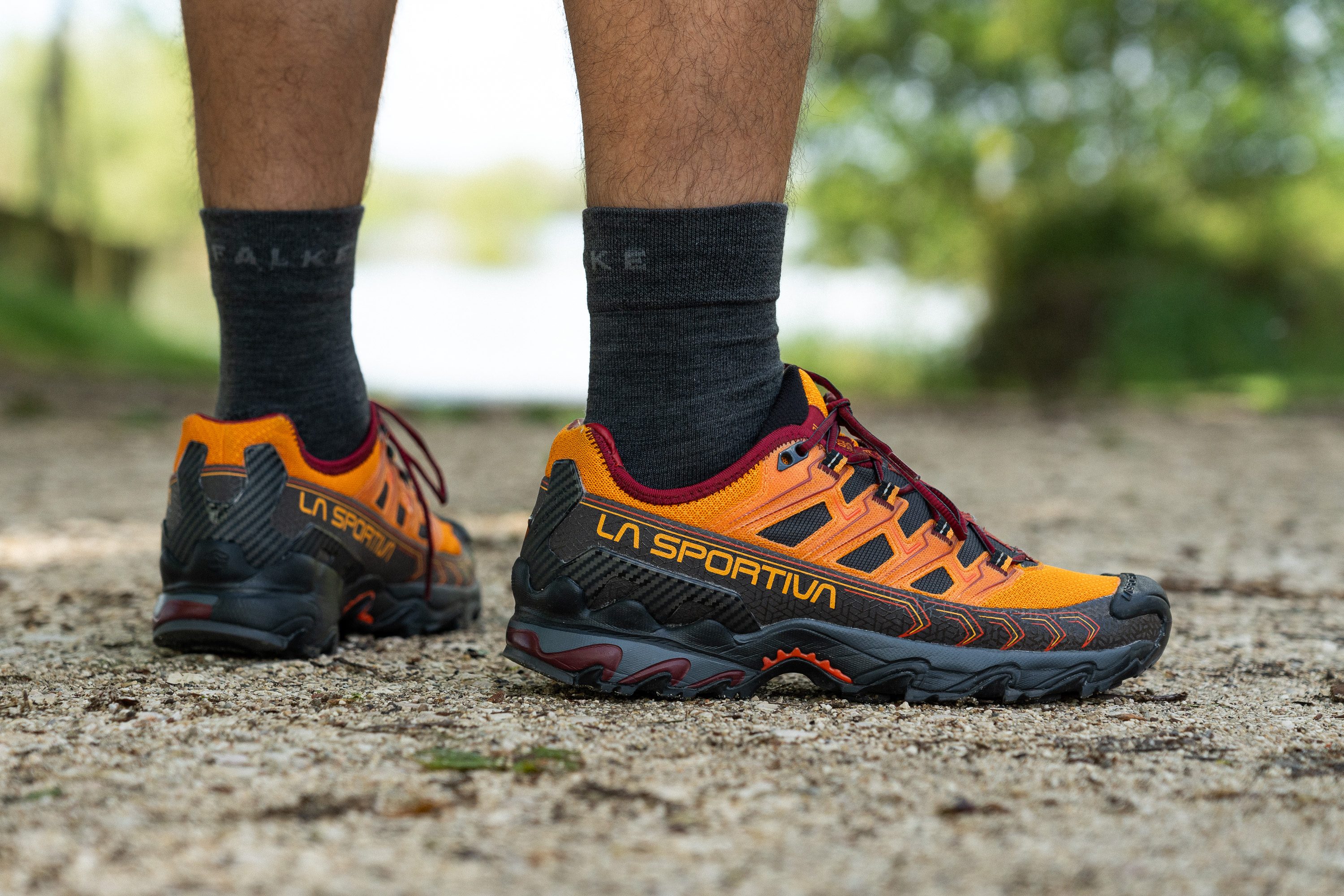
Who should NOT buy
If you need a trail shoe for easier hikes on moderate terrain, you can save a ton of money by choosing Merrell shoes like the Moab 3 or the Moab Speed 2.
Both of these shoes also have a more accommodating fit for medium and wide feet.
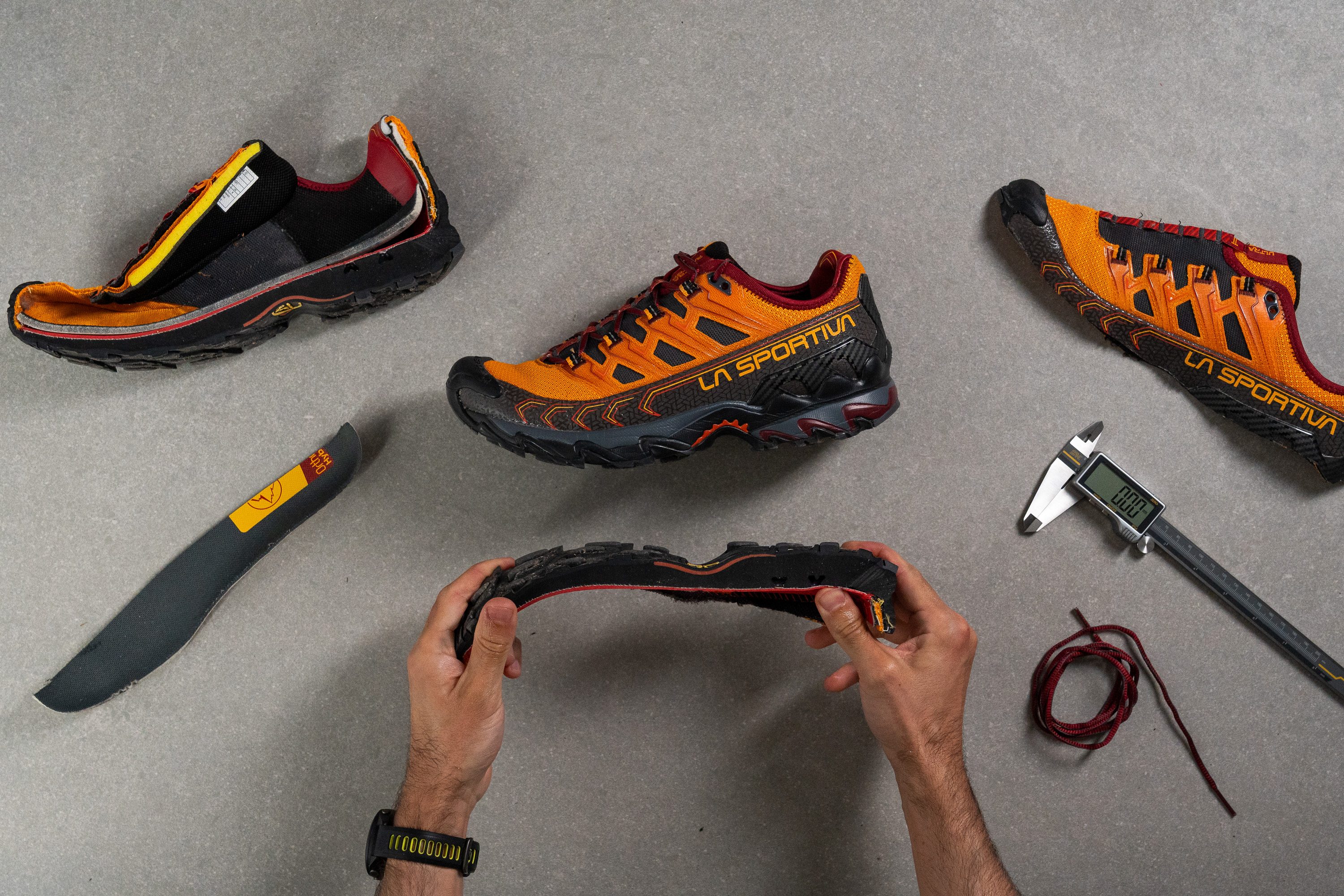
Cushioning
Shock absorption
NewThe Ultra Raptor II offers an impressive level of shock absorption for a shoe that's meant for challenging and technical terrain.
With a solid measurement of 105 SA, it guards the foot from painful encounters with rocks and other sharp debris while reducing stress on the joints on even terrain. It is a perfect example of a shoe that ensures underfoot protection without compromising ground feel or precise foot placement.
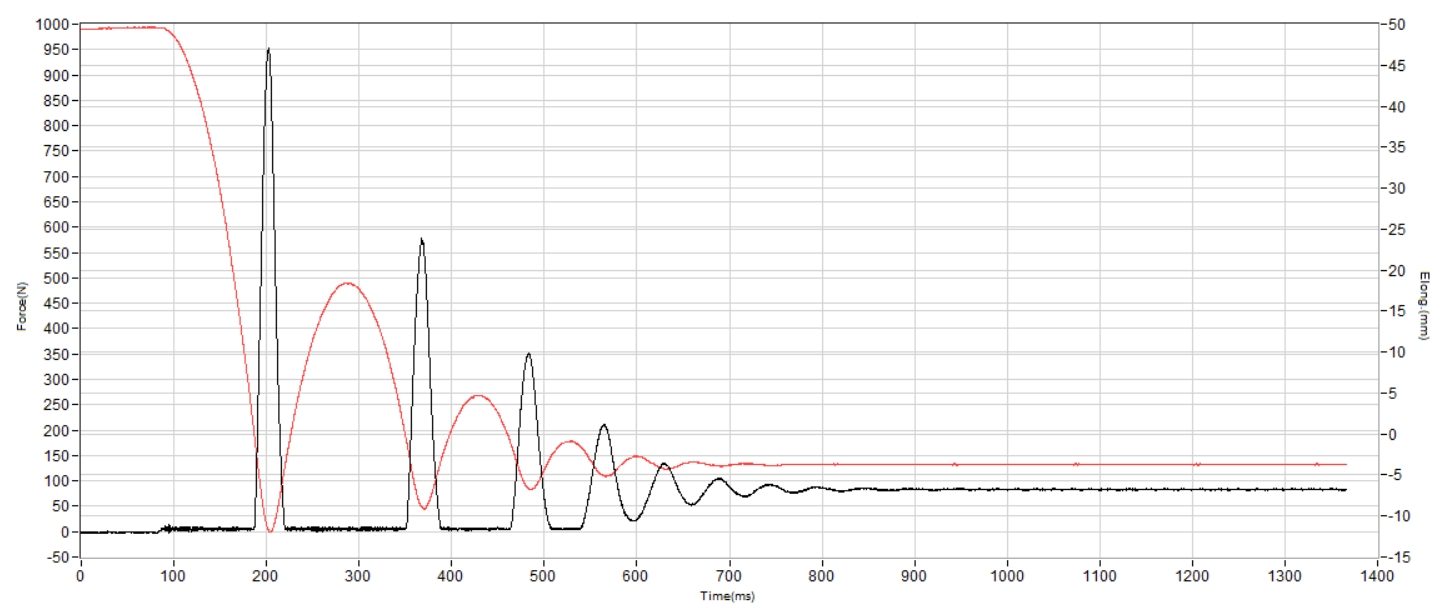
| Ultra Raptor II | 105 SA |
| Average | 104 SA |
Energy return
NewBut keep in mind that this is a low-rebound shoe that prioritizes stable and planted footing over a bouncy ride. That's why it has a minimal energy return of 45%.
| Ultra Raptor II | 44.7% |
| Average | 50.2% |
Heel stack
From our own experience, the Ultra Raptor II's midsole strikes a nice balance between ground feel and impact protection. So when we cut the shoe in half in our lab, its stack measurements reflected just that.
The heel stack showed a middle-of-the-pack height of 32.7 mm which we believe is good enough for a rock-heavy alpine route. You don't want to feel too isolated as it would be harder to correct a misstep on a taller platform.
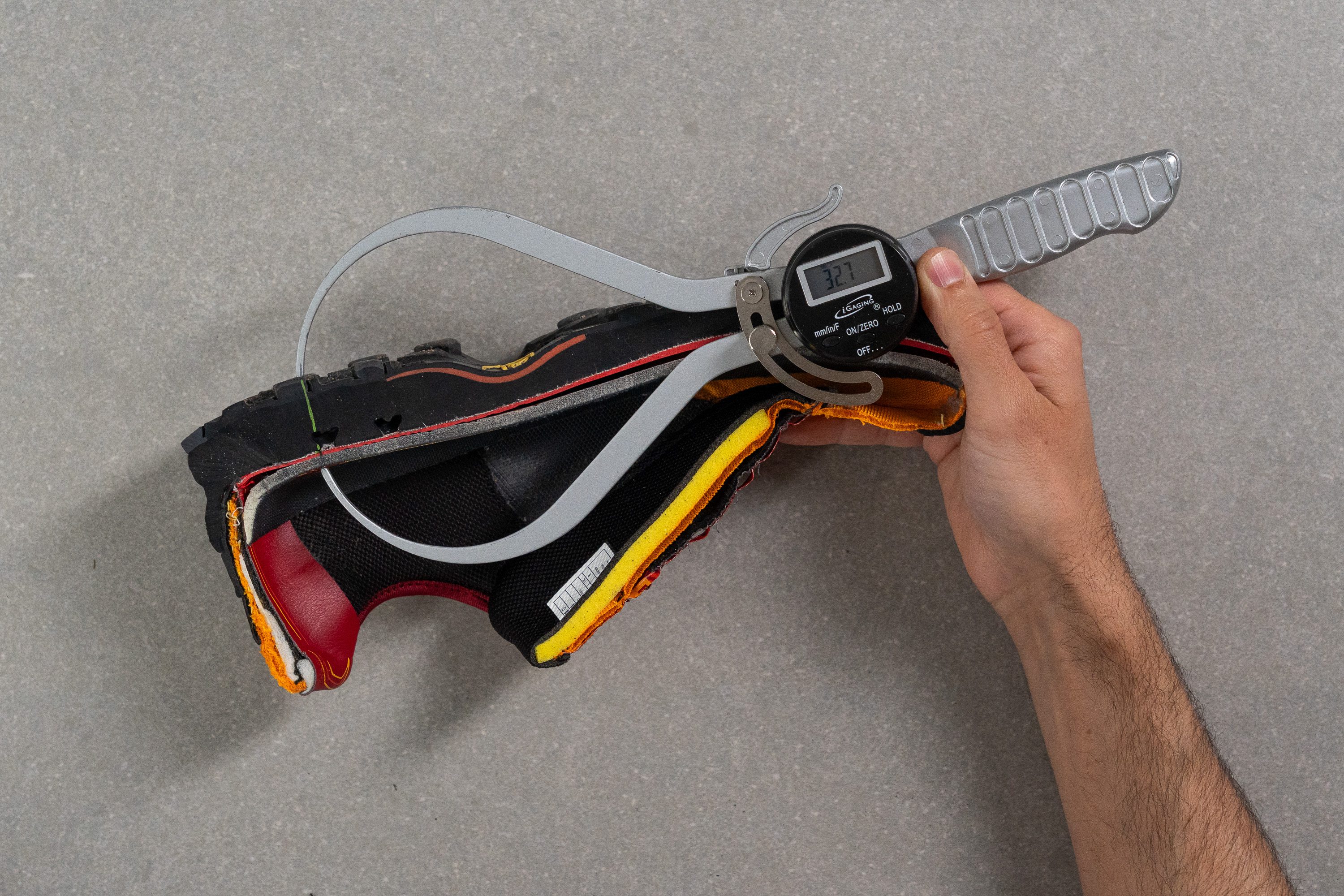
| Ultra Raptor II | 32.7 mm |
| Average | 32.8 mm |
Forefoot stack
A moderate forefoot stack of 22.1 mm also helps the shoe feel more down-to-earth. But, at the same time, there is just enough impact protection for the ball of foot and the toe joints.

| Ultra Raptor II | 22.1 mm |
| Average | 22.0 mm |
Drop
Checking the difference between the shoe's stack heights, we get a heel-to-toe drop of 10.6 mm.
In this setup, the heel is slightly elevated above the toe level which eases the strain on the foot and the Achilles tendon. It is on par with the category average, so most hikers should get a familiar experience.
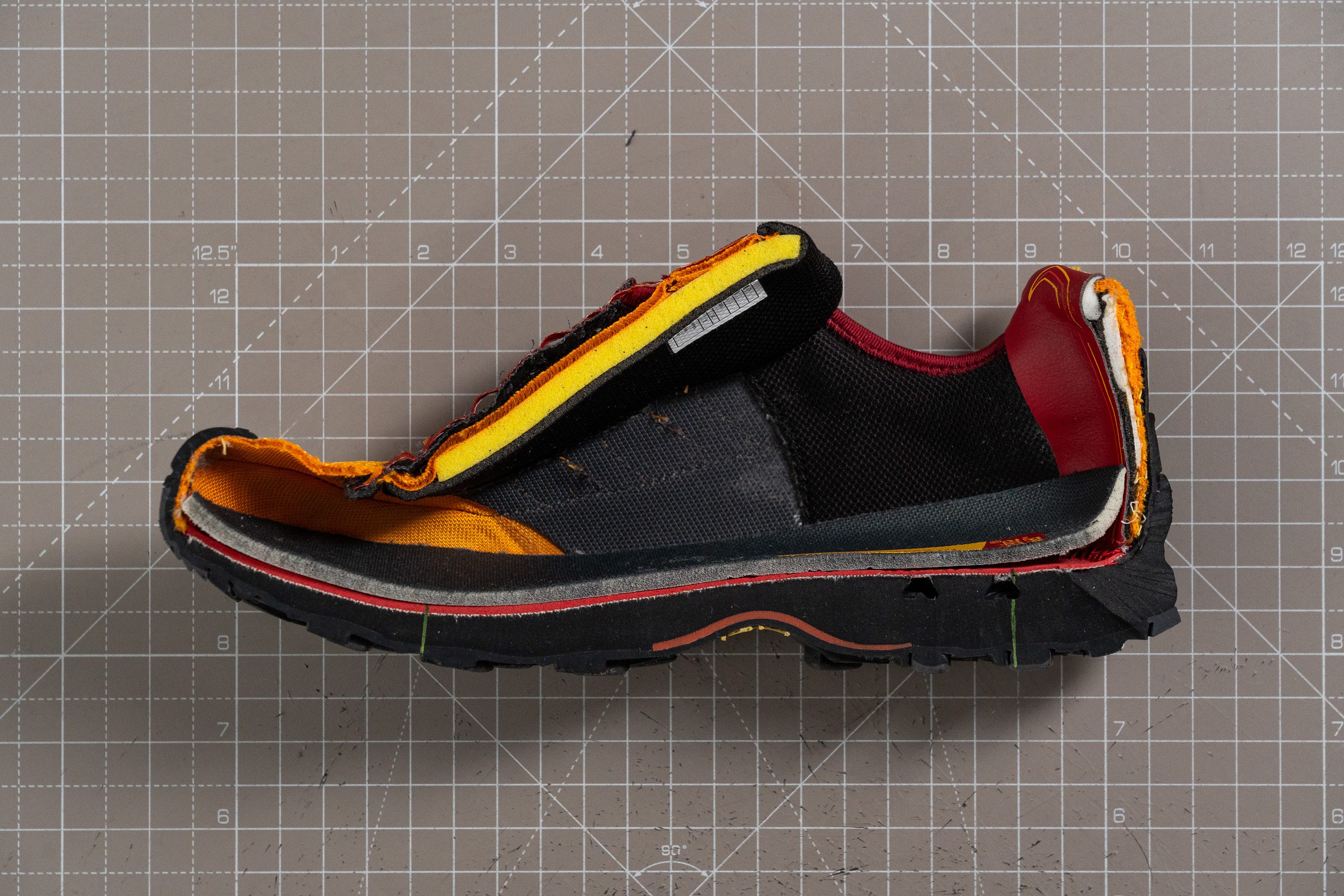
| Ultra Raptor II | 10.6 mm |
| Average | 10.7 mm |
Midsole softness
Because La Sportiva markets the Ultra Raptor II as a hiking and trail running shoe, it features an Infused EVA foam for its midsole cushioning. This compound is described as more responsive than the brand's Compressed EVA foam (used in its hiking and backpacking-oriented shoes).
However, the Raptor didn't strike us as a particularly fun and bouncy trail runner shoe, especially compared to our top picks in this category.

Pressing our Shore A durometer against its EVA foam returned a high reading of 29.5 HA which only confirmed its hardness. The average cushioning softness of current trail running shoes hovers around 22.0 HA (35% softer than the Raptor) offering a notably more numble experience.
| Ultra Raptor II | 29.5 HA |
| Average | 27.0 HA |
Rocker
Because this La Sportiva shoe is supposed to double as a trail runner, it comes with a noticeable toe spring (aka toe rocker).
We found this geometry particularly beneficial for thru hiking as it made our toe-offs smoother and helped to reduce some muscular effort on steep inclines.
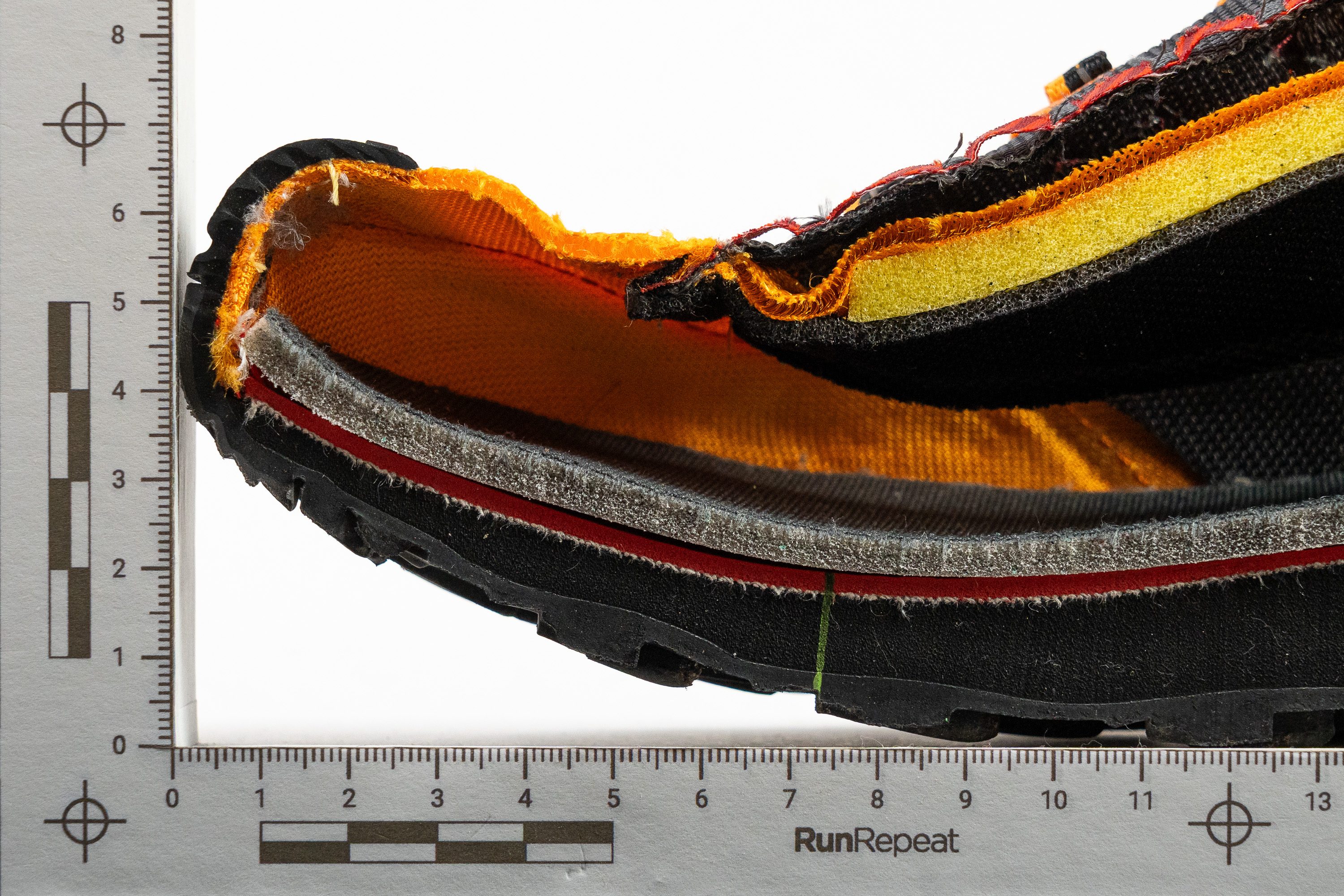
Size and fit
Size
La Sportiva Ultra Raptor II fits half size small (14 votes).
Consider sizing up
Width / Fit
Despite its burly-looking appearance, the La Sportiva Ultra Raptor II is a very snug and close-fitting shoe on the inside. And it is reflected in the shoe's very skinny gel mold.
Measuring the widest part of the replica with a digital caliper, we found that it is only 90.1 mm wide at the widest part. This is notably slimmer than average, even for a medium-width foot.
But luckily, you can opt for the shoe's wide version which is supposed to add 10 mm of toebox circumference and 5 mm of toebox height.
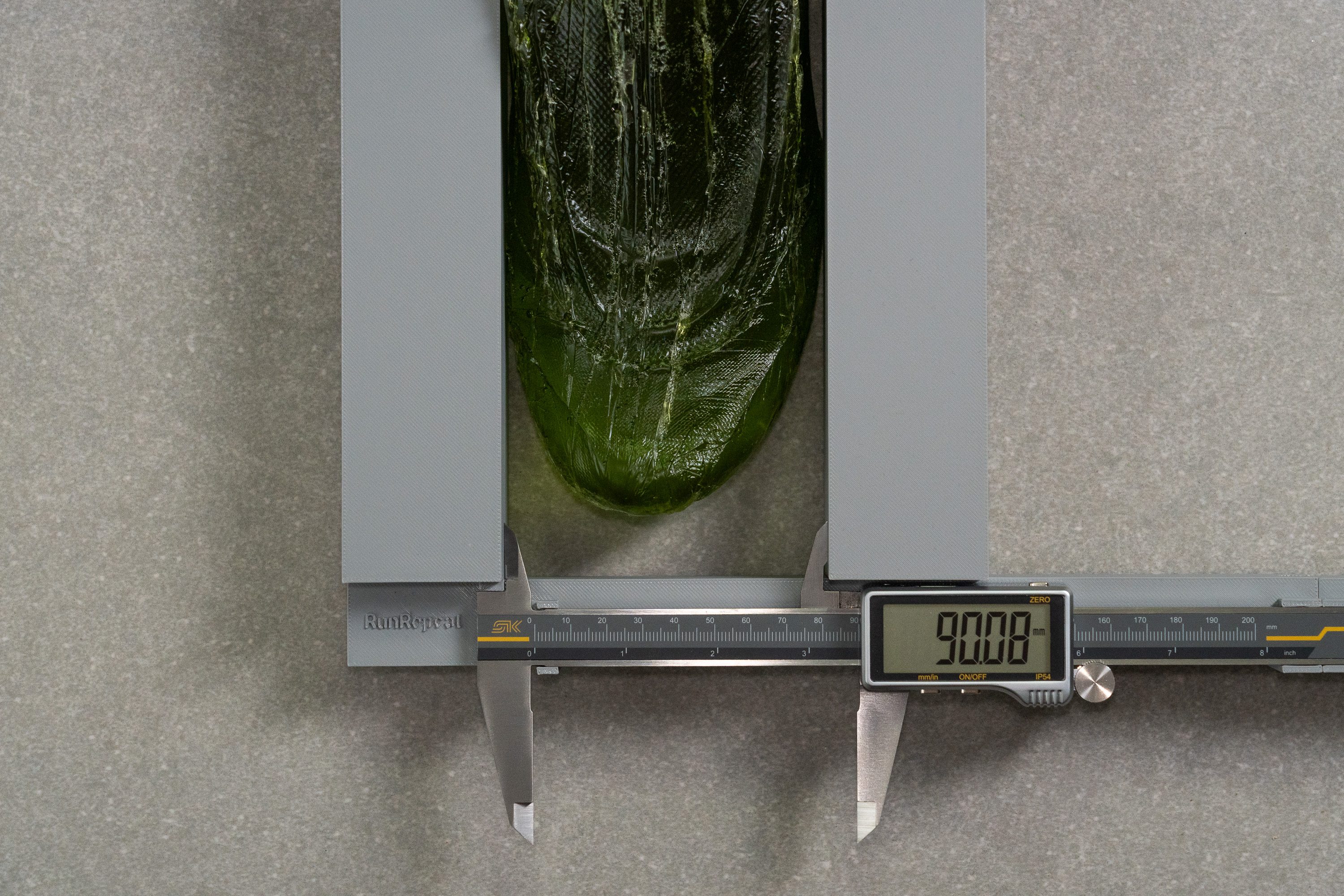
| Ultra Raptor II | 90.1 mm |
| Average | 94.1 mm |
Toebox width
As expected, the shoe doesn't get any wider in its toebox either. Measuring its width in the big toe area, we got another below-average reading of 68.8 mm.
So not only is the Ultra Raptor II a narrow shoe in general, it also comes with a narrow toebox. That makes it one of the slimmest hiking shoes in our lab.
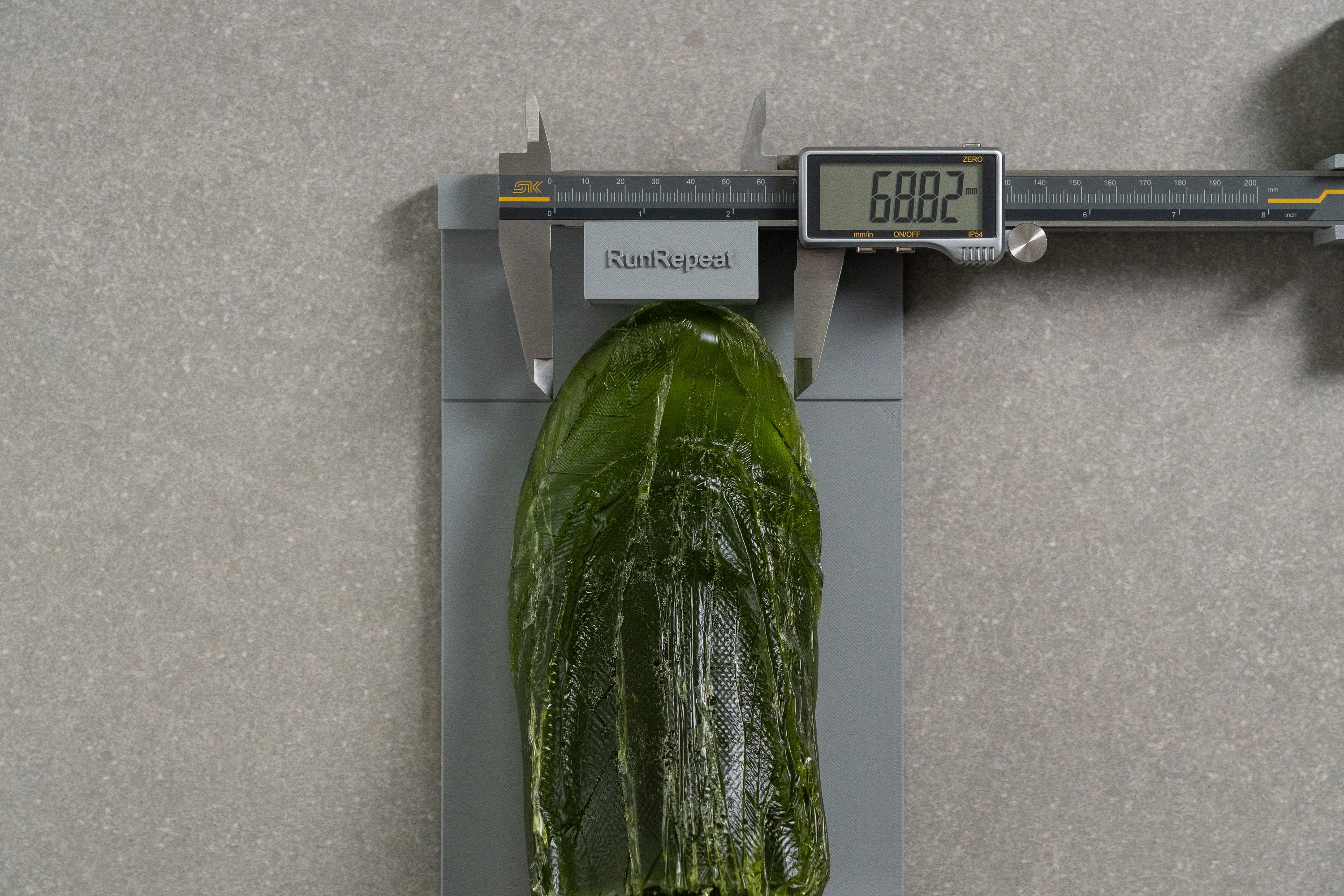
| Ultra Raptor II | 68.8 mm |
| Average | 72.5 mm |
Toebox height
We also found the shoe's toebox height to be lower than average at 25.3 mm.
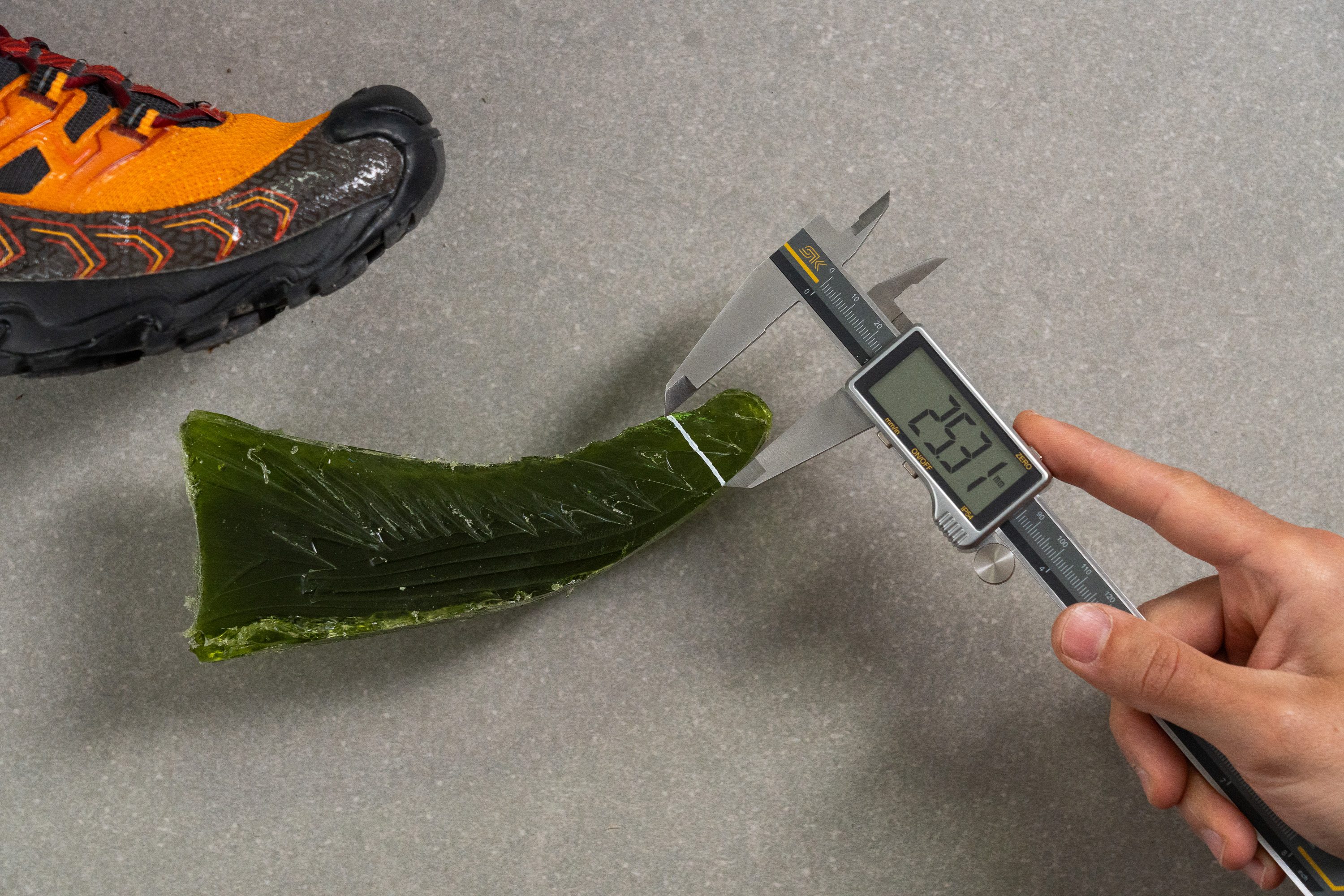
We wouldn't say that its vertical space is too restricted but it is certainly limited by the large toe bumper.
| Ultra Raptor II | 25.3 mm |
| Average | 28.0 mm |
Traction / Grip
Lug depth
So long as its outsole remains intact, the Ultra Raptor II offers some of the best grip you can expect in a hiking shoe.
Even though its lug depth showed a standard reading on our caliper (4.4 mm), the shoe feels much toothier than that number suggests thanks to the sticky nature of its rubber.
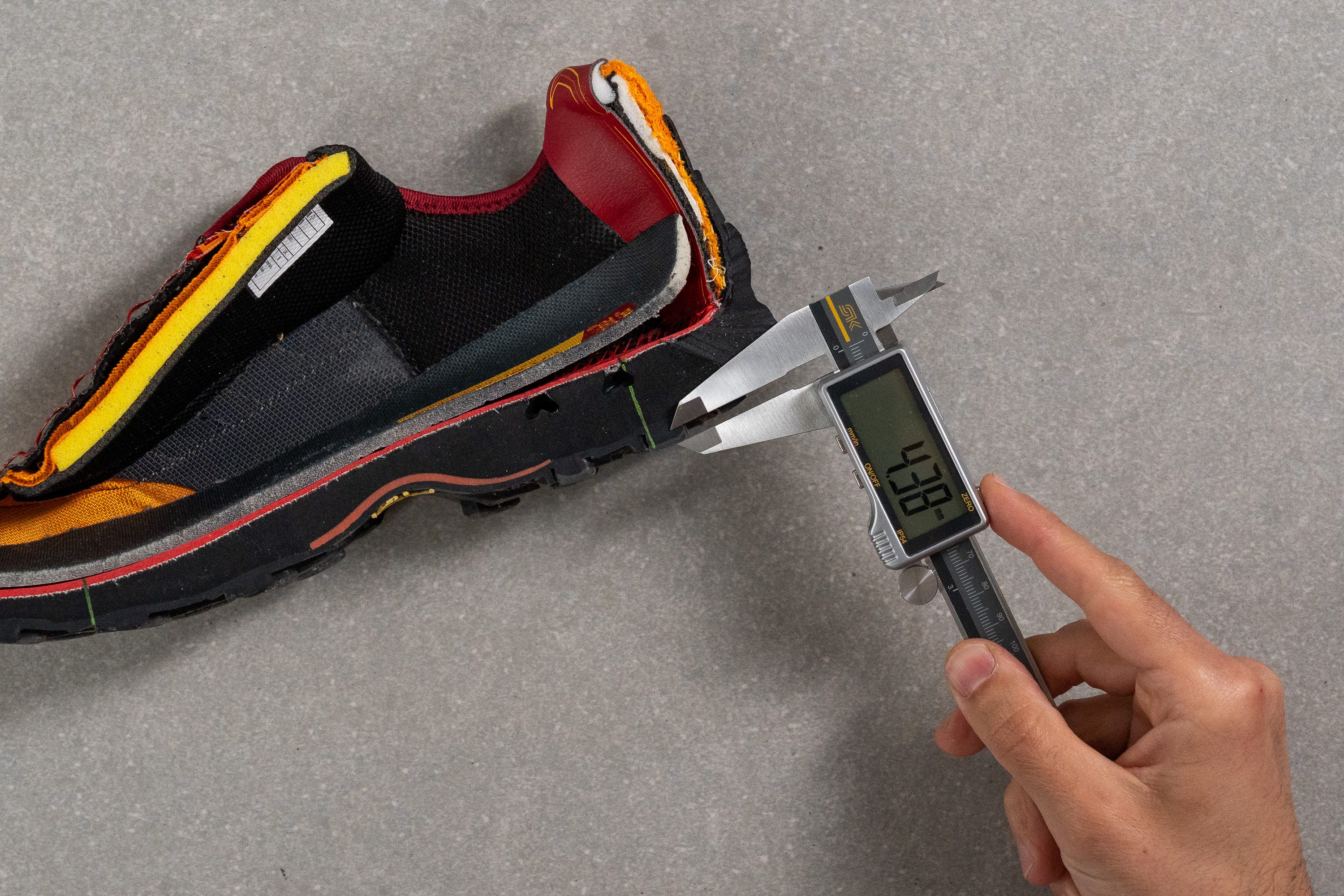
This La Sportiva shoe inspired a lot of confidence on both dry and wet surfaces including wet rocks, mossy logs, and grassy descents. It's not ideal for peanut butter mud situations though, as you would want a deeper (5-6 mm) treading for that.
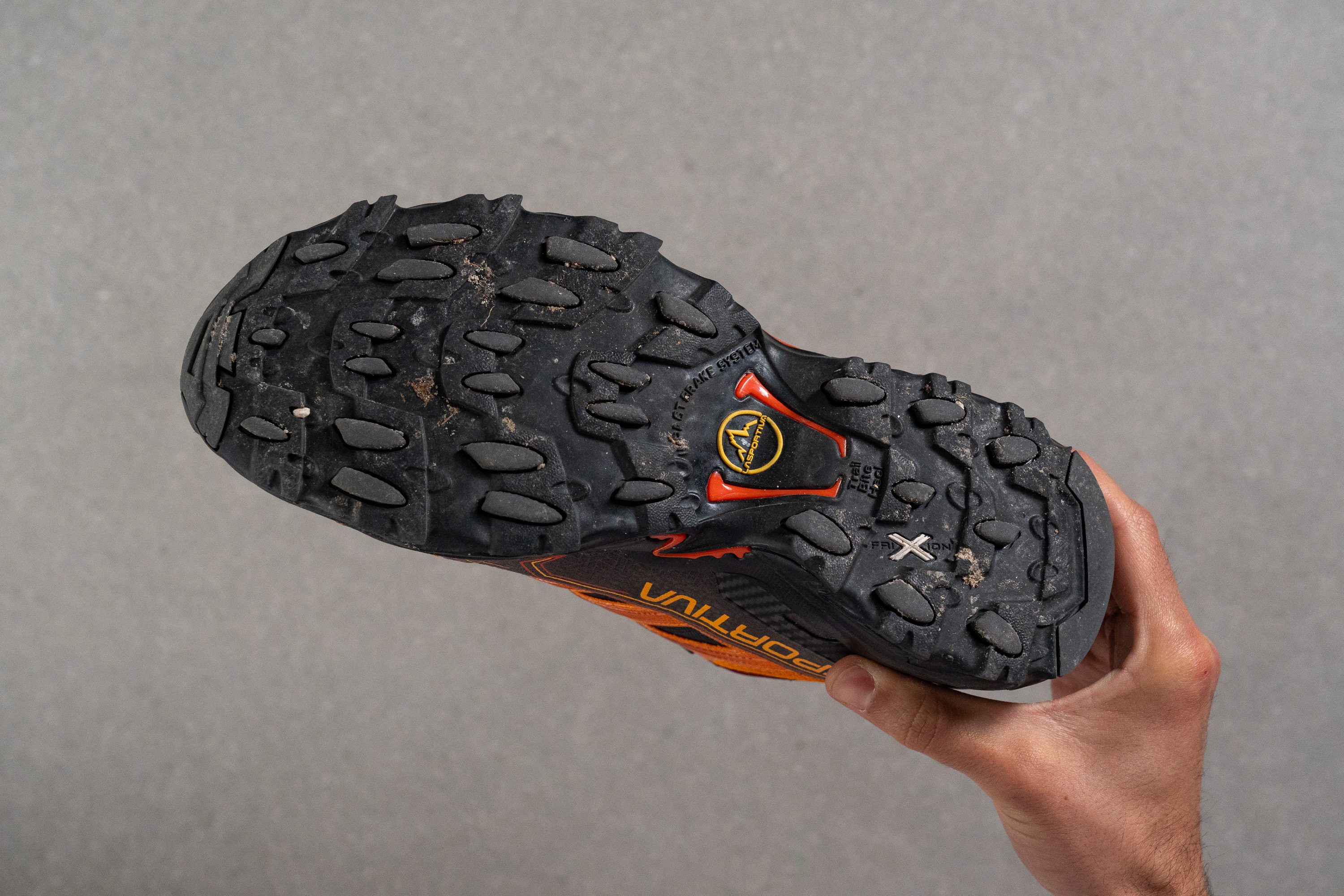
| Ultra Raptor II | 4.4 mm |
| Average | 4.0 mm |
Flexibility / Stiffness
The Raptor II's pliable forefoot was a pleasant surprise considering how stiff and heavily layered its construction is.
Requiring only 11.2N of force to bend by 30 degrees, this La Sportiva shoe turned out to be even more flexible than the average hiking shoe! It is 60% more pliable, to be precise.
In fact, this is one of the features that makes the Raptor feel a bit more like a running shoe. We also enjoyed the added forefoot flexibility for navigating scree and climbing steeper slopes.
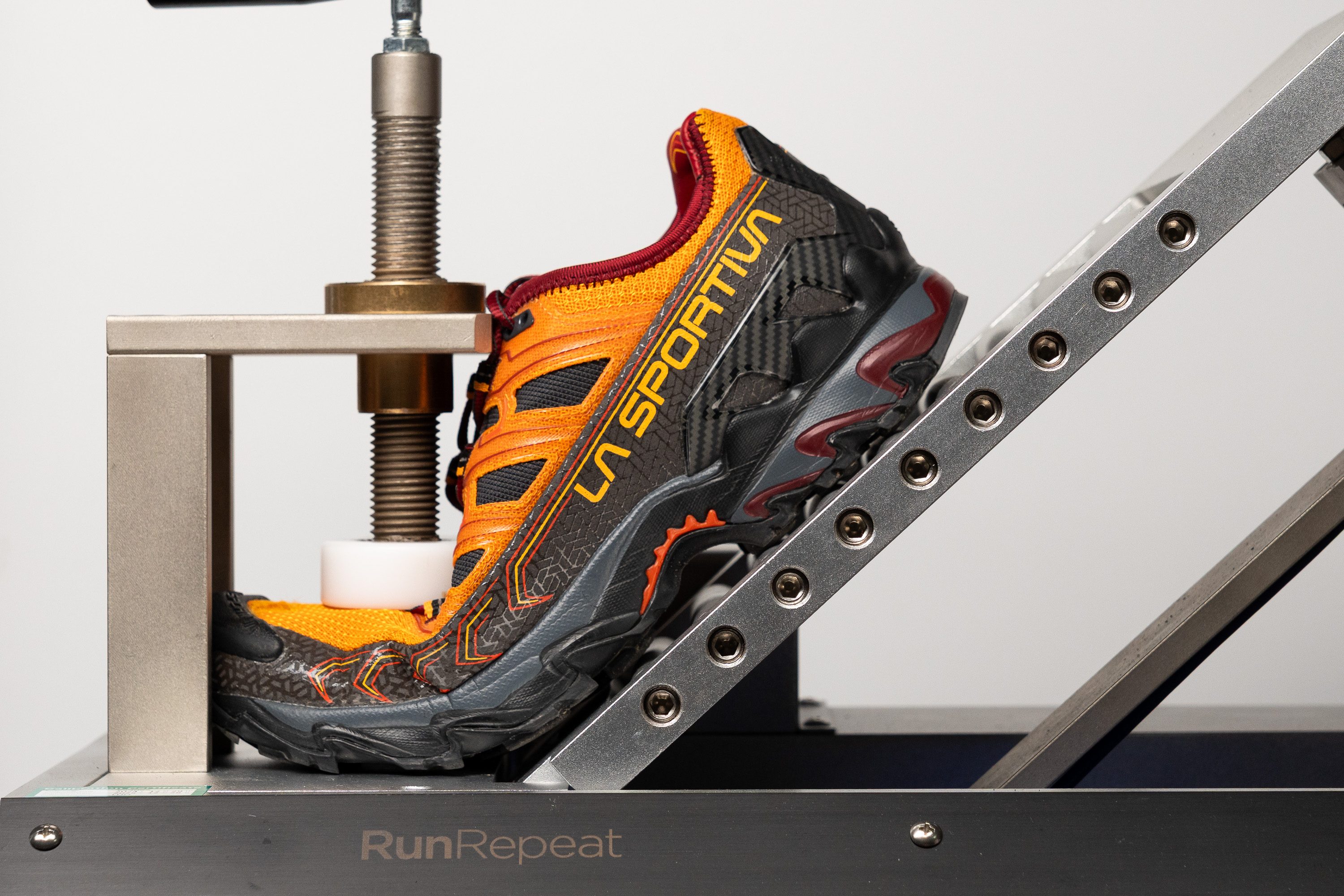
| Ultra Raptor II | 11.2N |
| Average | 18.3N |
Weight
The Ultra Raptor II sits right at the average of non-waterproof hiking shoes with a scale measurement of 12.65 oz (359g). In lieu of the Gore-Tex membrane, it is half an ounce lighter than the Ultra Raptor II GTX.
Even though you can always find lighter options for day hiking, we didn't feel like the Raptor was taxing on our feet at the end of the day.
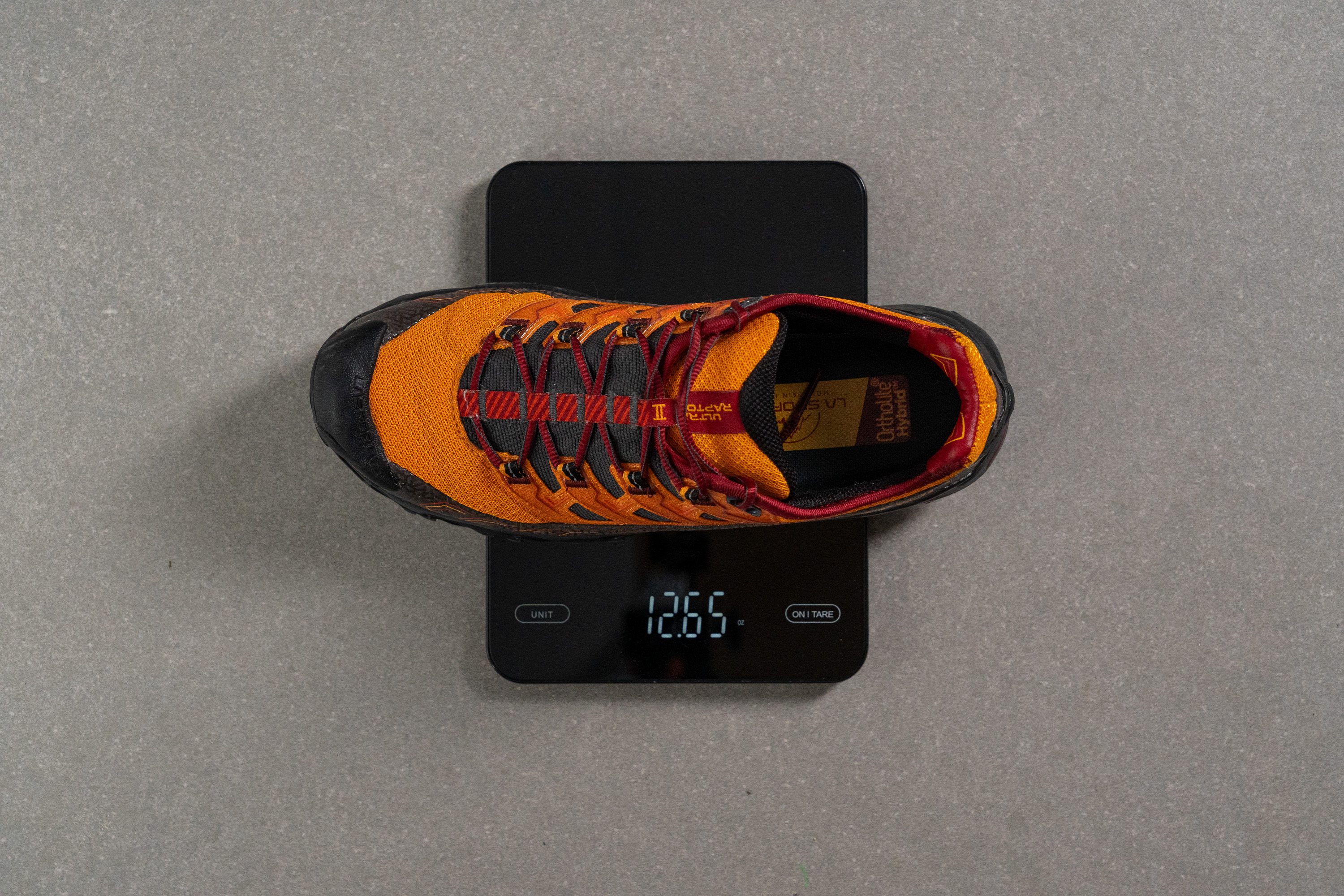
| Ultra Raptor II | 12.7 oz (359g) |
| Average | 13.4 oz (380g) |
Breathability
The Ultra Raptor II is a more summer-ready verison of this La Sportiva shoe series and it uses a pretty thin and transparent mesh to provide the neded breathability.
Our smoke-pumping test revealed the fabric's decent ventilation capacity for warm weather. But because it's not the best airflow we've experienced in hiking shoes, the Raptor only got a moderate breathability score of 3/5.
If you hike in hot climates and need the best possible foot aeration, take a look at our breathable hiking shoe catalog.
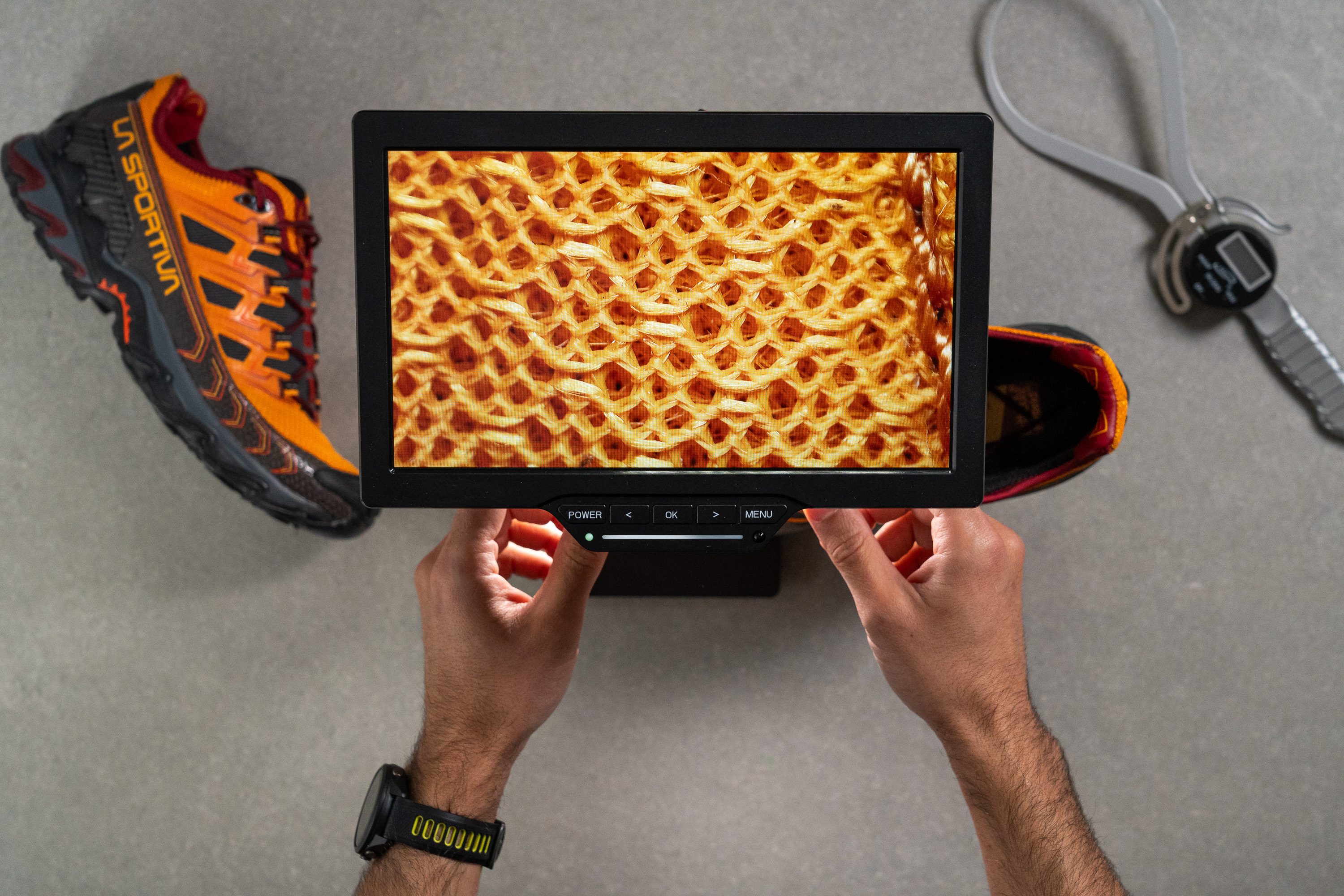
| Ultra Raptor II | 3 |
| Average | 2.4 |
Stability
Lateral stability test
Stability is the Ultra Raptor II's forte!
The shoe made us feel exceptionally surefooted on rock-heavy, uneven, and often unprfedictable technical terrain.
There was aboslutely no foot buckling or tippiness thanks to the shoe's many supportive elements and TPU reinforcements.
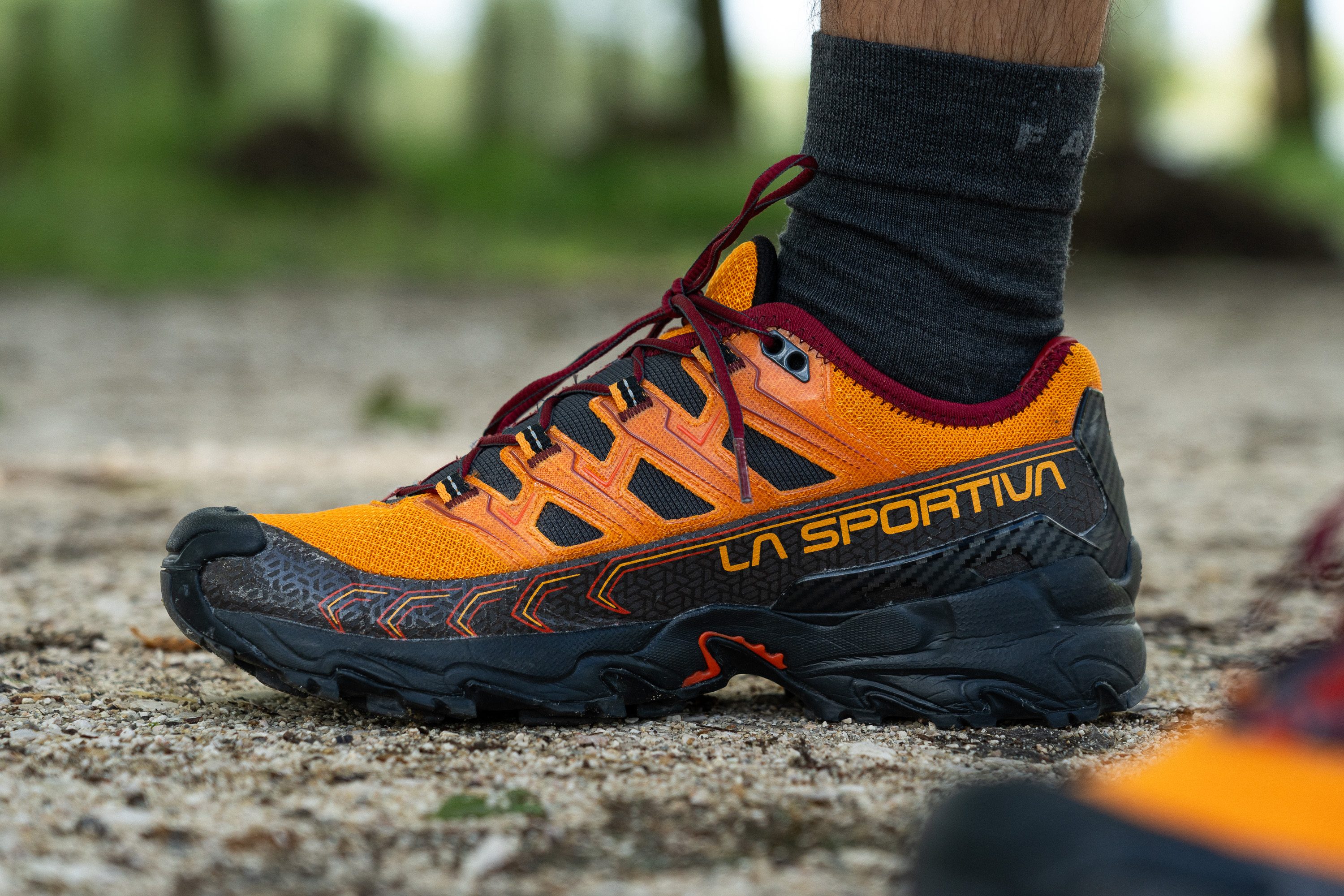
Torsional rigidity
The shoe wouldn't yield to our manual twisting and earned a high stiffness score of 4/5.
This is exactly the kind of support you want when traversing uneven terrain with a heavy pack. Not only does it reduce the chance of rolling or sparining the ankle but also minimizes foot fatigue on long distances.
The shoe's firm foam carrier, TPU heel clips, and sturdy upper overlays all work together to keep the foot stable in the La Sportiva Ultra Raptor II.
But there is one more essential component hidden inside the shoe's midsole - a stiff midfoot shank that helps to generate a ton of torisonal rigidity while protecting the foot from stepping on harsh elements.
| Ultra Raptor II | 4 |
| Average | 3.7 |
Heel counter stiffness
Having previously tested the Raptor II GTX, we were surprised that the non-GTX version of the shoe didn't have the same heel stiffness!
Even though both shoes feature the exact same EVA and TPU frames, they have slightly different collar designs and the regular Raptor II happens to be the more pliable one.
On the bright side, our heels and ankles felt quite stable in the regular Raptor II but we felt the need to use that top double eyelet to get a more secure lockdown in this shoe.
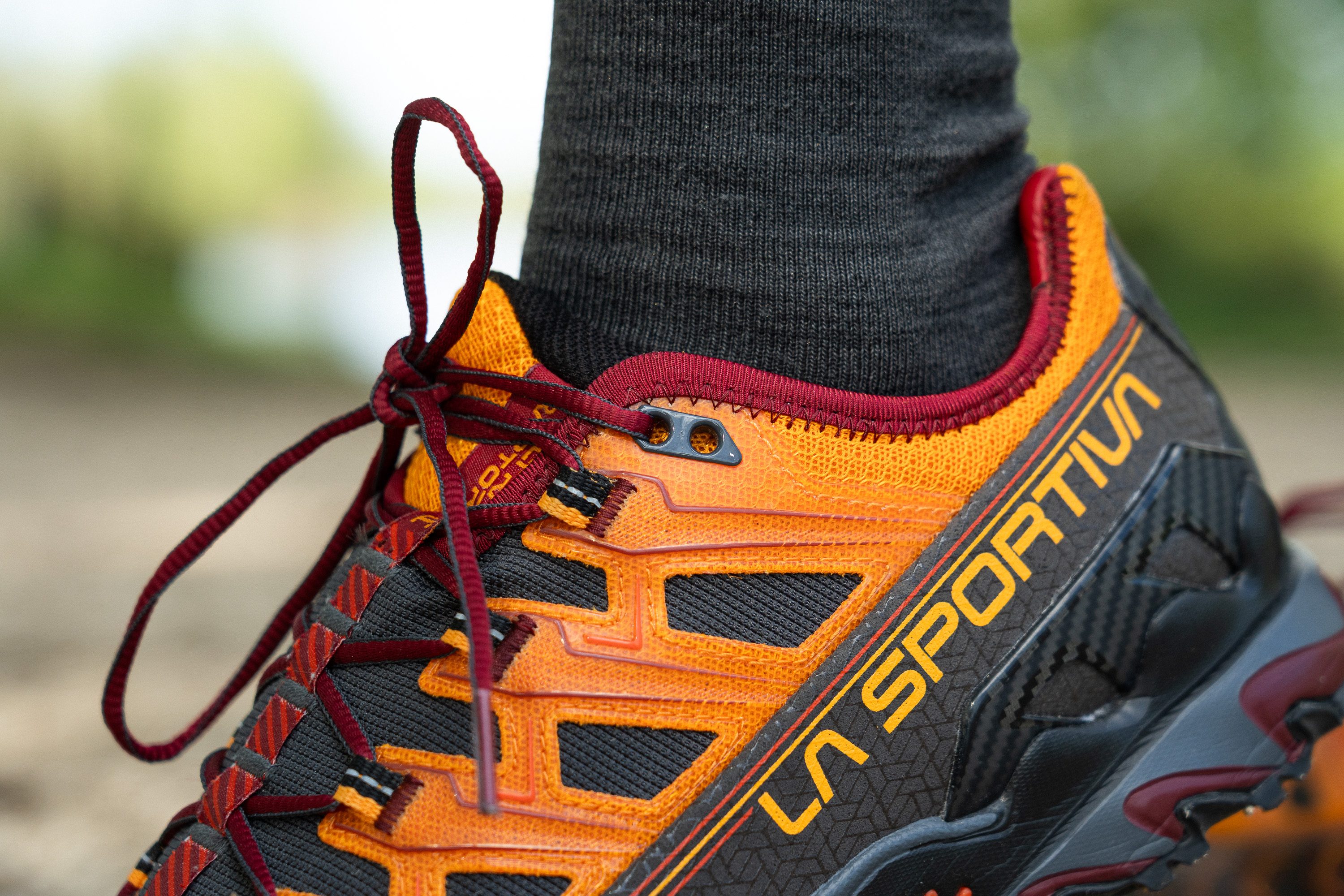
| Ultra Raptor II | 3 |
| Average | 3.7 |
Midsole width - forefoot
When it comes to staying stable on technical terrain, you need to have a decently wide base but not too wide to compromise your foot placement precision.
La Sportiva respects that by making the Ultra Raptor II's midsole just enough wide. Our caliper measured the widest part of the forefoot at 108.6 mm which is slightly below the average.
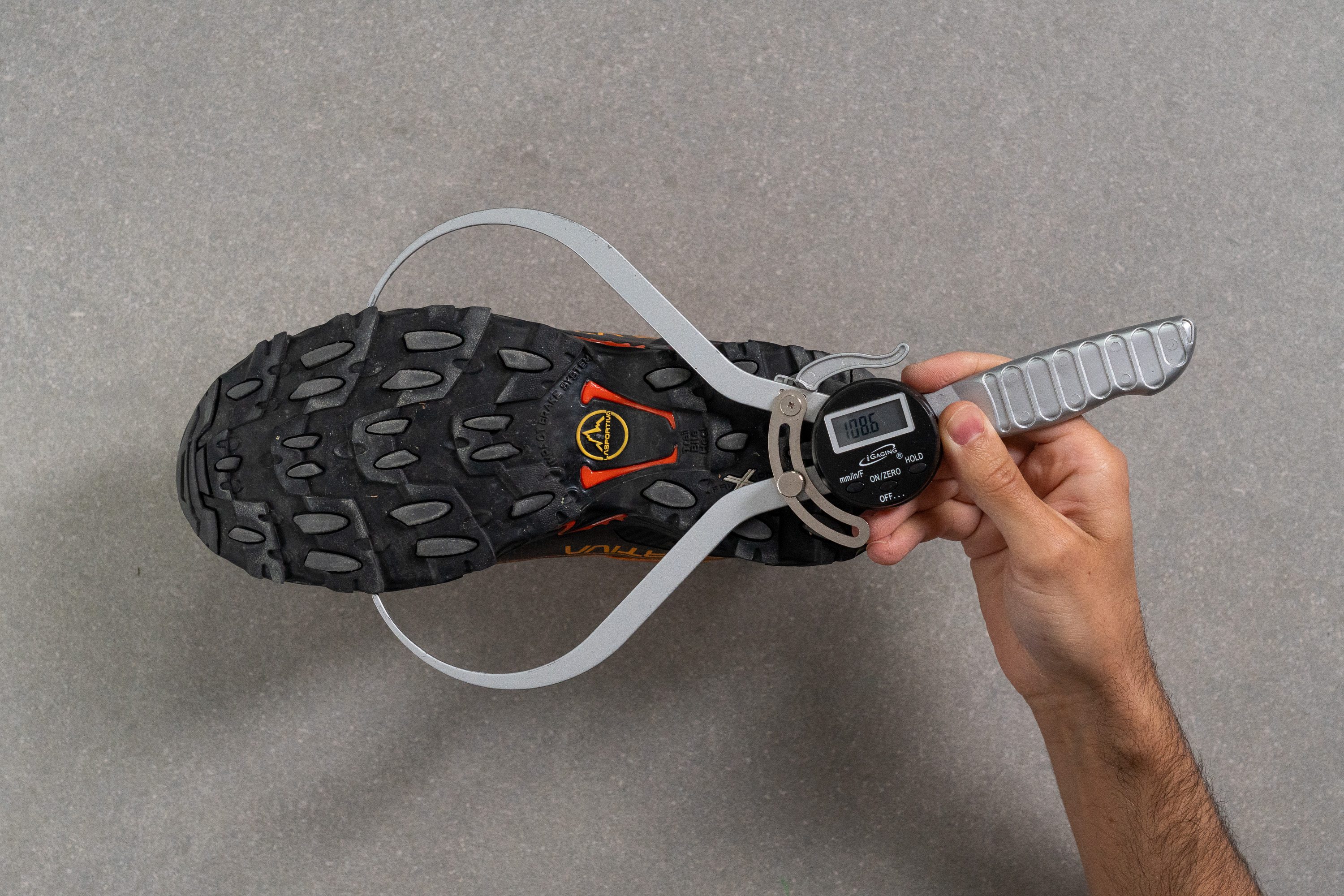
| Ultra Raptor II | 108.6 mm |
| Average | 111.3 mm |
Midsole width - heel
Consequently, the shoe's heel is not very wide either. Its widest area showed another below-average reading of 83.5 mm on our caliper.
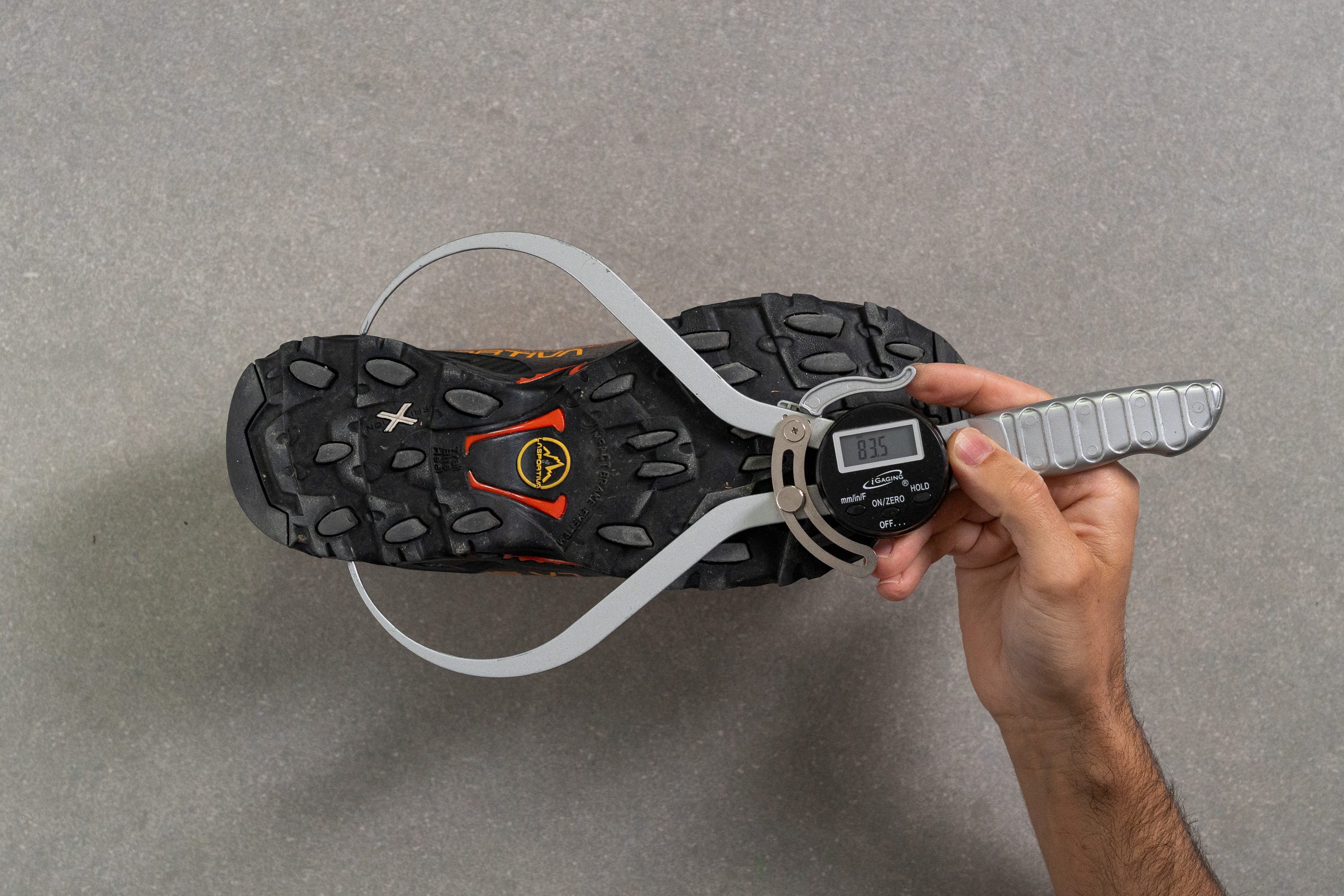
| Ultra Raptor II | 83.5 mm |
| Average | 87.9 mm |
Durability
Toebox durability
Please note that the Ultra Raptor II's increased breathability comes with a price and you can't expect the same abrasion resistance as the Raptor GTX provides. The two shoes clearly have different immunity to sharp bushes and rock slashes:

Both materials went through the same Dremel test and the non-GTX version proved to be notably less durable. It was almost completely torn by sandpaper and thus received a low toebox durability score of 2/5.
But the good news is that the Ultra Raptor II is also reiniforced with a microfiber band on the sides of the forefoot and features an equally sturdy rubber toe bumper as its tougher GTX counterpart. So at least the most hazardous and wear-prone areas are covered.
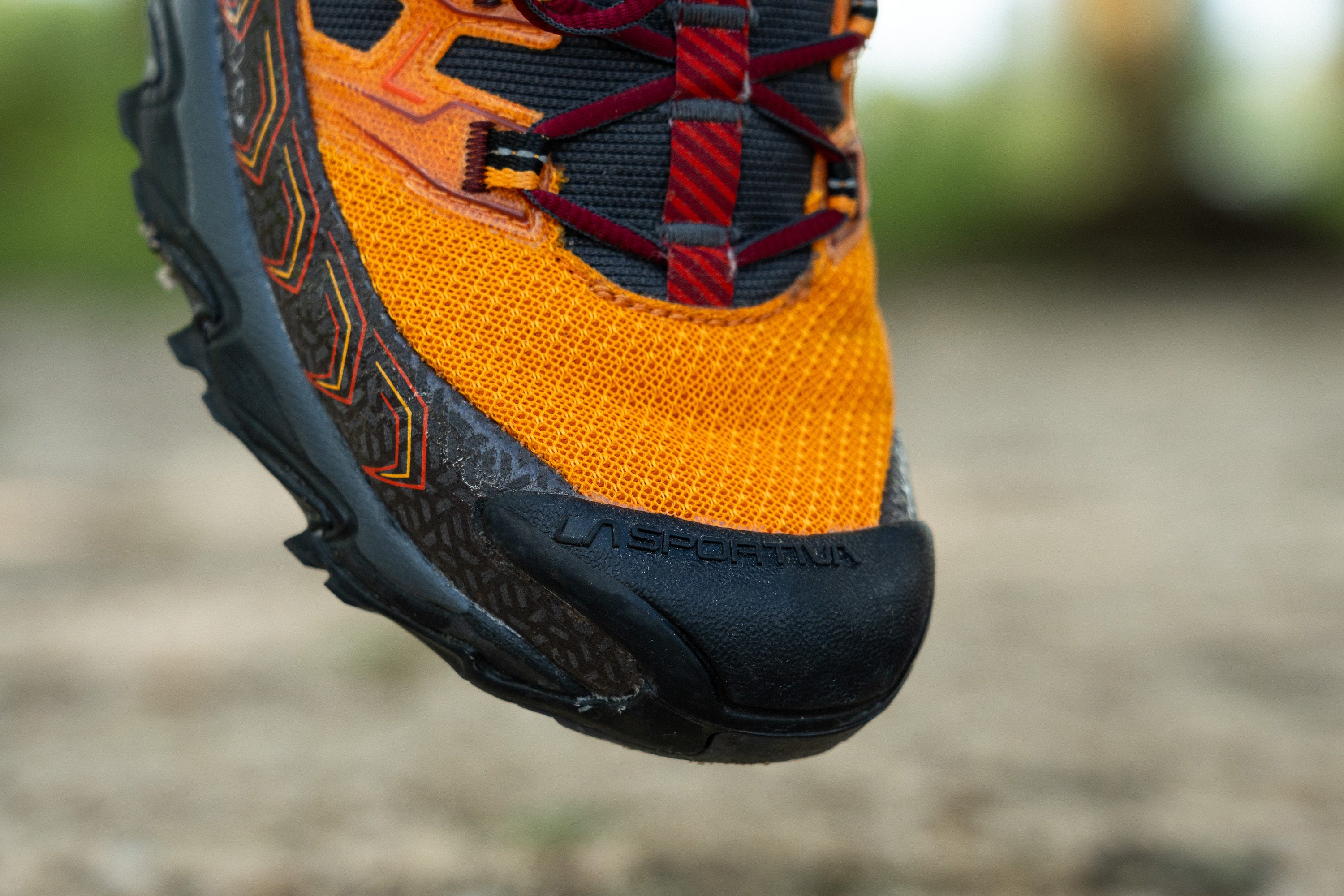
| Ultra Raptor II | 2 |
| Average | 3.7 |
Heel padding durability
We don't normally see it in hiking shoes but La Sportiva chose leather for the Ultra Raptor II's inner collar lining. The material showed excellent wear resistance in our Dremel test though (4/5), so we can't complain.
But we would recommend wearing higher socks to avoid Achilles chafing and hot spots, espeically during the break-in period.
| Ultra Raptor II | 4 |
| Average | 3 |
Outsole hardness
The Ultra Raptor II features the brand's proprietary FriXion White outsole rubber and that means both good and bad news.
The good news is the incredibly tacky grip that comes with it.
But the bad news is that it's not the most durable outsole blend. Even though it showed solid hardness on our Shore C durometer (84.0 HC), our Dremel test revealed its weakness.
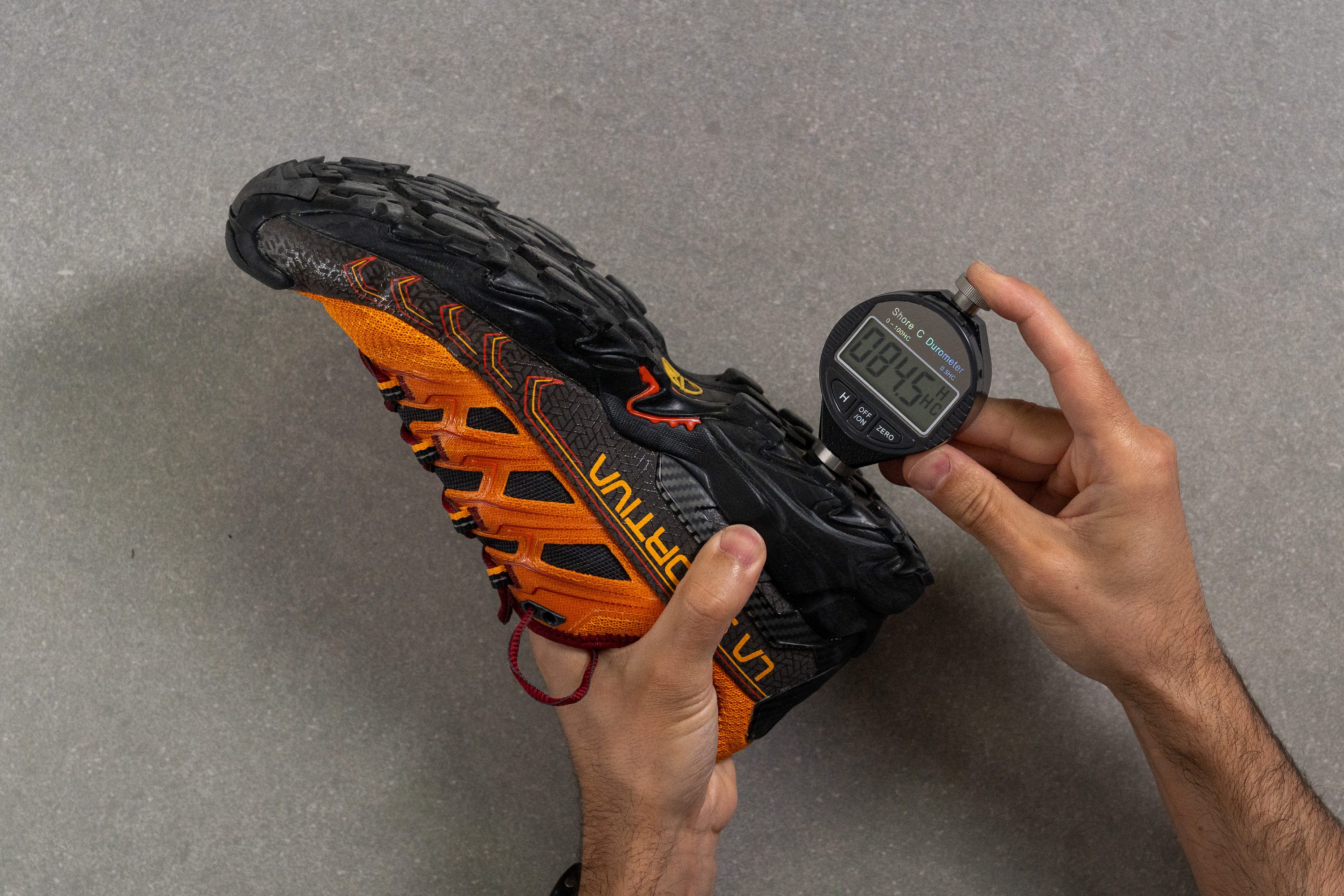
| Ultra Raptor II | 84.0 HC |
| Average | 85.1 HC |
Outsole durability
Drilling one of the shoe's lugs at 10K RPM speed for 18 seconds, we were disappointed at how quickly the tool chipped away the rubber bits.
One could argue that a 1.2 mm dent is not that deep compared to the category average but considering the price of this La Sportiva shoe, it is quite disappinting. There are much cheaper hiking shoes whose dent was only 0.3 mm (i.e. Salomon Outpulse).
| Ultra Raptor II | 1.2 mm |
| Average | 1.0 mm |
Outsole thickness
Good to see that the shoe's outsole thickness is on par with the average at 2.4 mm. But given its lack of durability, you might start losing lugs (and grip) sooner than you expected.
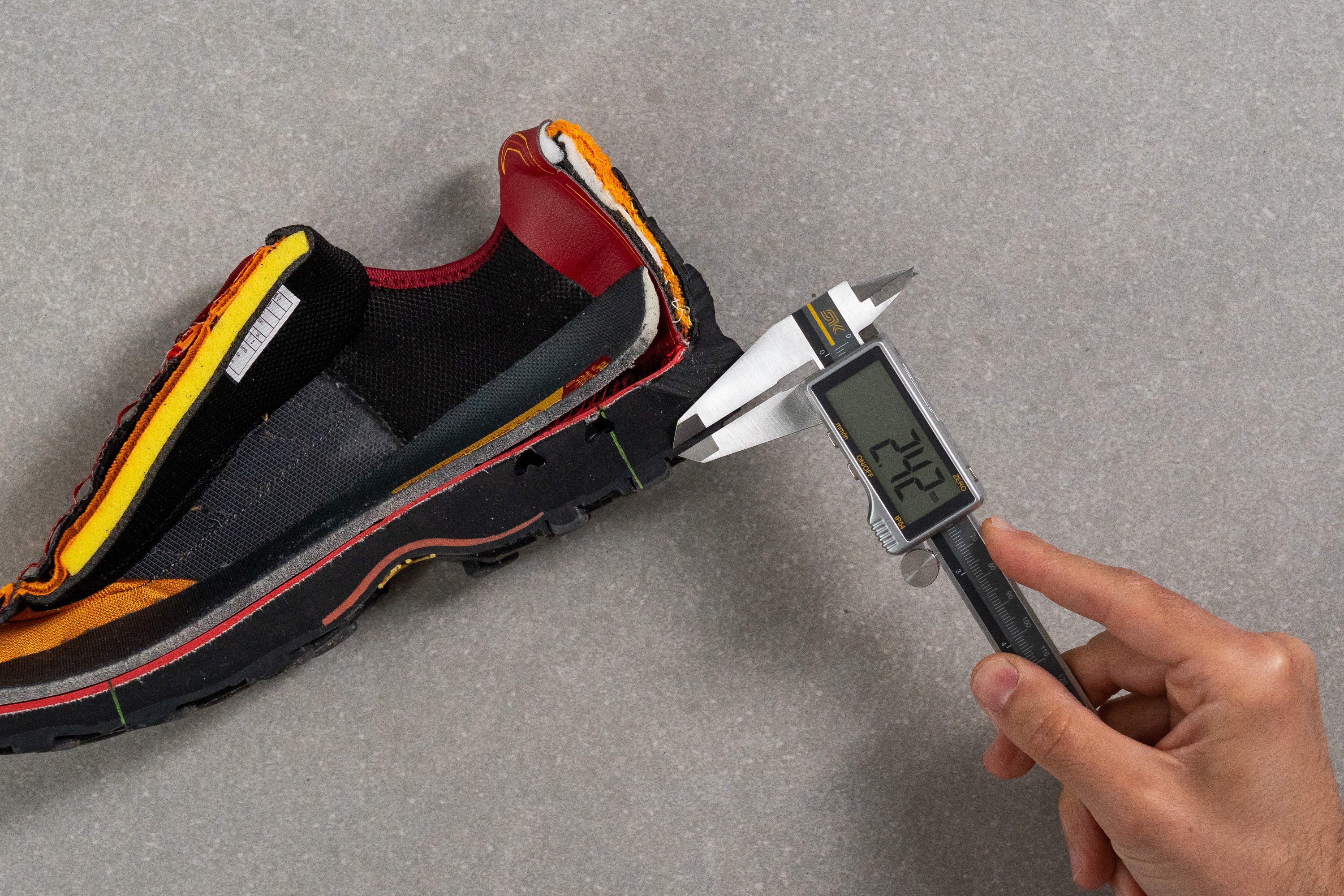
| Ultra Raptor II | 2.4 mm |
| Average | 2.5 mm |
Misc
Insole thickness
The shoe's OrthoLite insole is decently thick at 3.5 mm but it's not as generously padded as some other hiking shoe insoles.
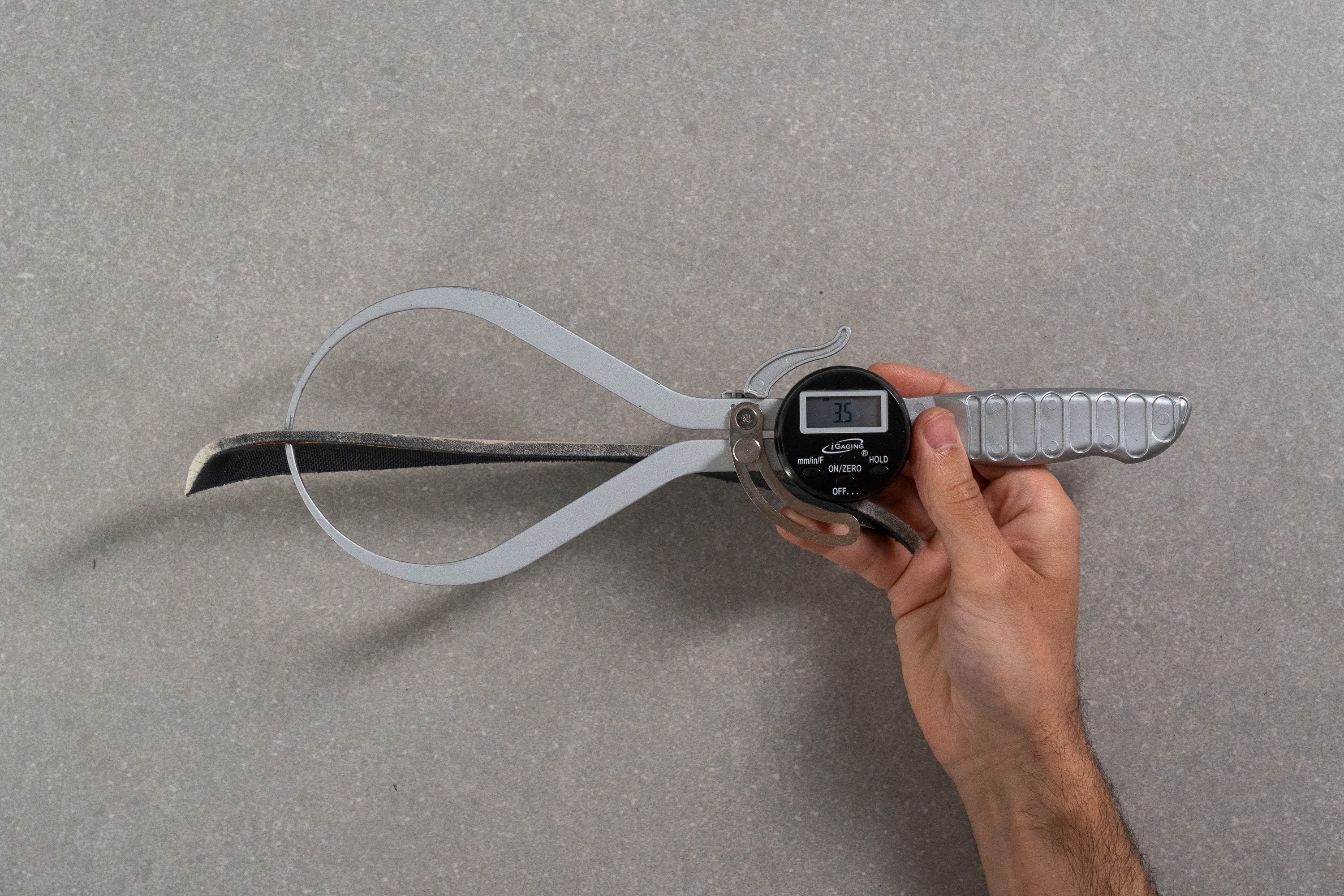
| Ultra Raptor II | 3.5 mm |
| Average | 5.3 mm |
Removable insole
The shoe's OrthoLite insole is easily removable in case you wish to add a thicker insert or a custom orthotic.
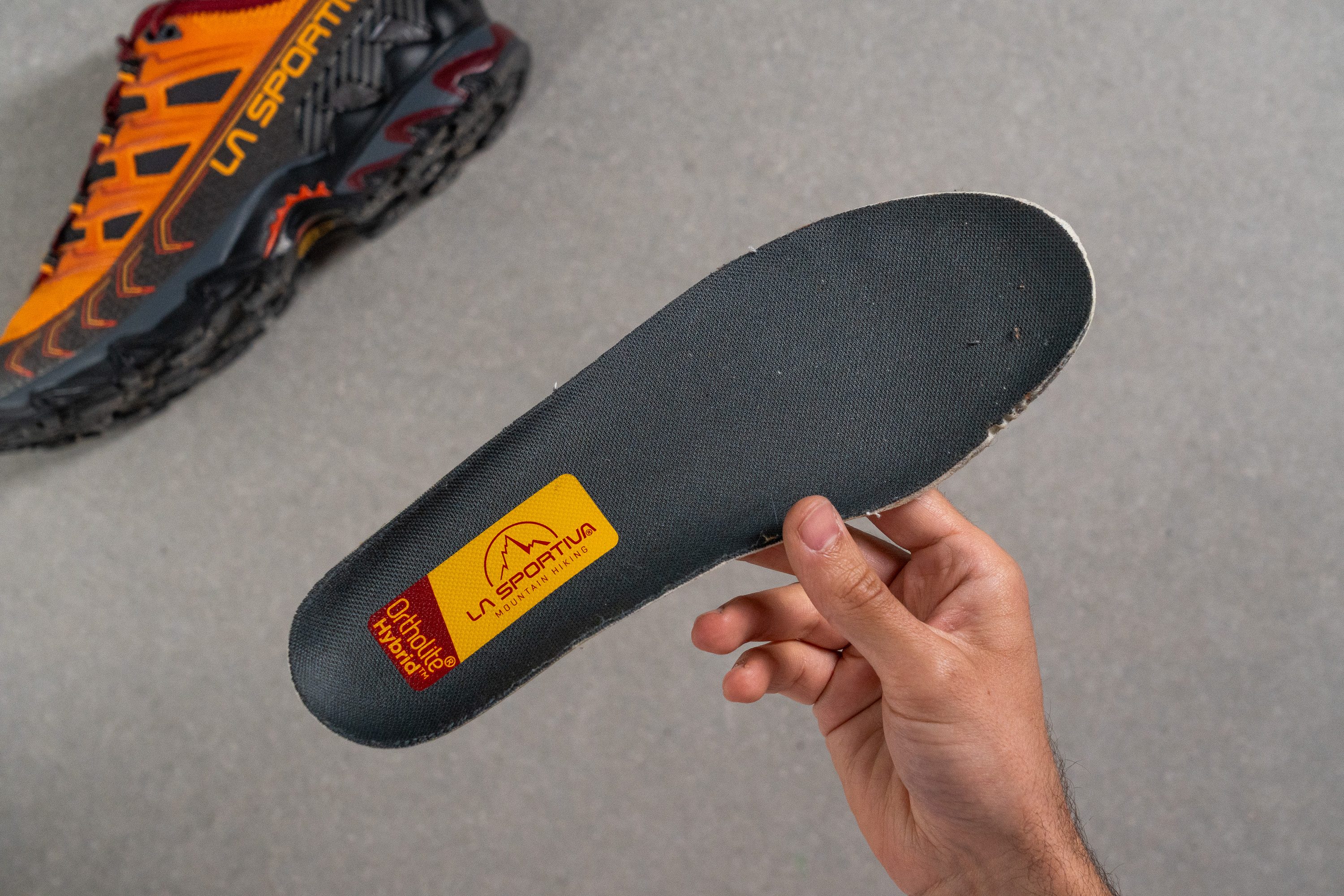
| Ultra Raptor II | Yes |
Midsole softness in cold (%)
A good thing about firm shoes is that they barely get any firmer in cold weather.
Having kept the Ultra Raptor II in the freezer for 20 minutes, we repeated the durometer measurement to see how the Injected EVA foam reacted to low temperature. With a moderate increase of 17%, it didn't get any harder than the average hiking shoe.
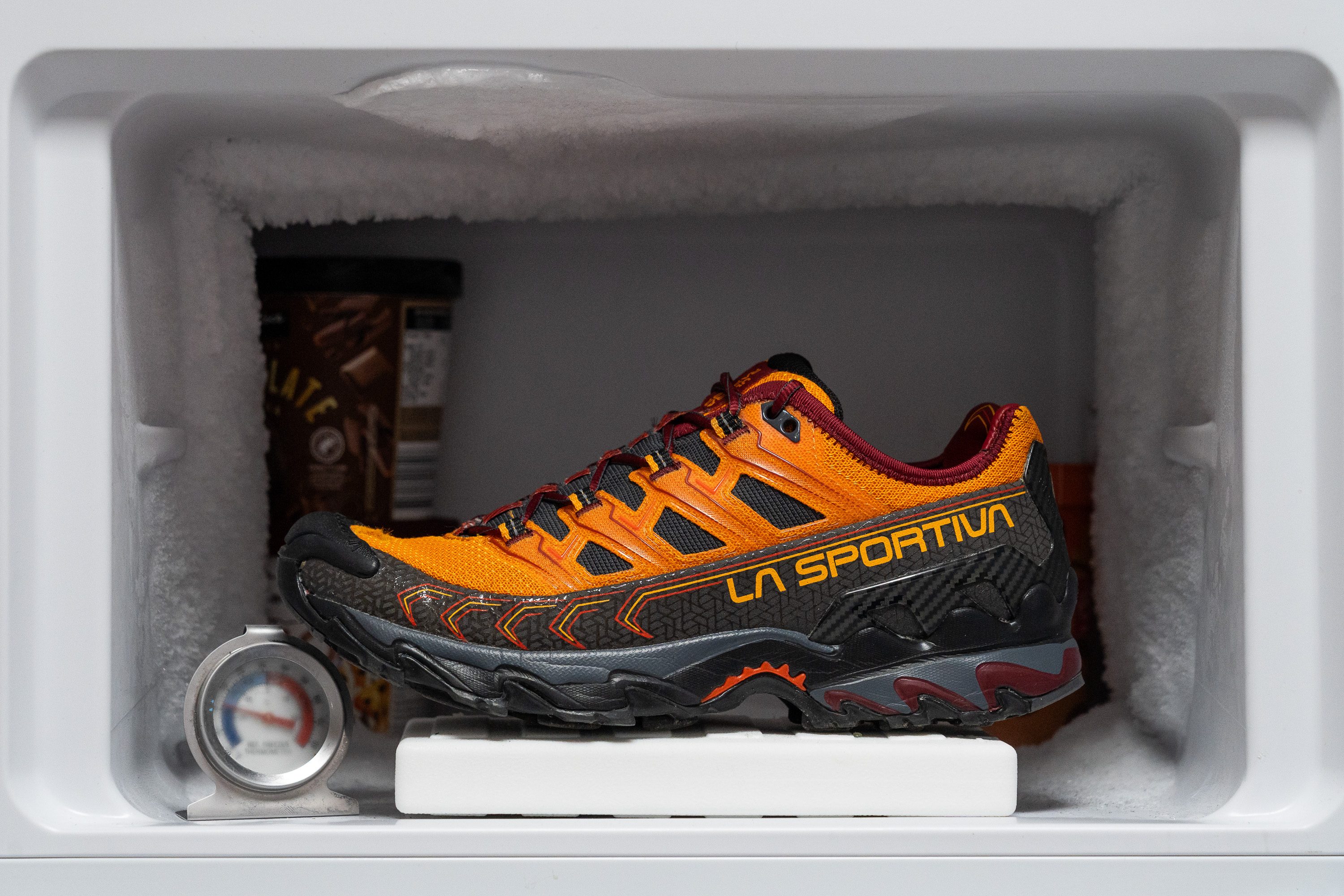
| Ultra Raptor II | 17% |
| Average | 19% |
Reflective elements
None of the shoe's components reflected light in our dark room test.
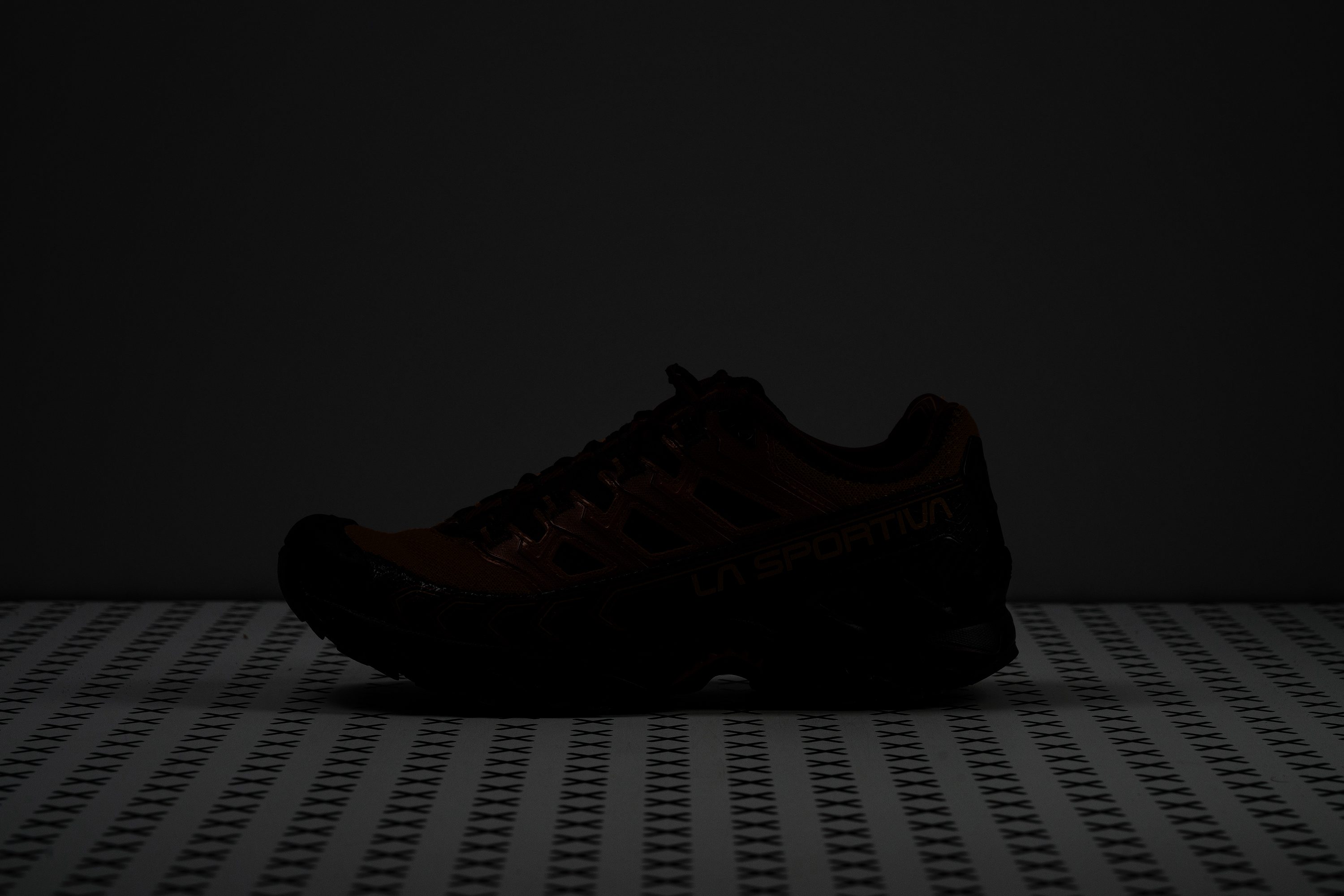
| Ultra Raptor II | No |
Tongue padding
The bulk of the shoe's inner padding appears to be concentrated in its tongue. Having cut the shoe in half, we found that its tongue padding is equally thick from the bottom to the top showing 12.2 mm on the caliper.
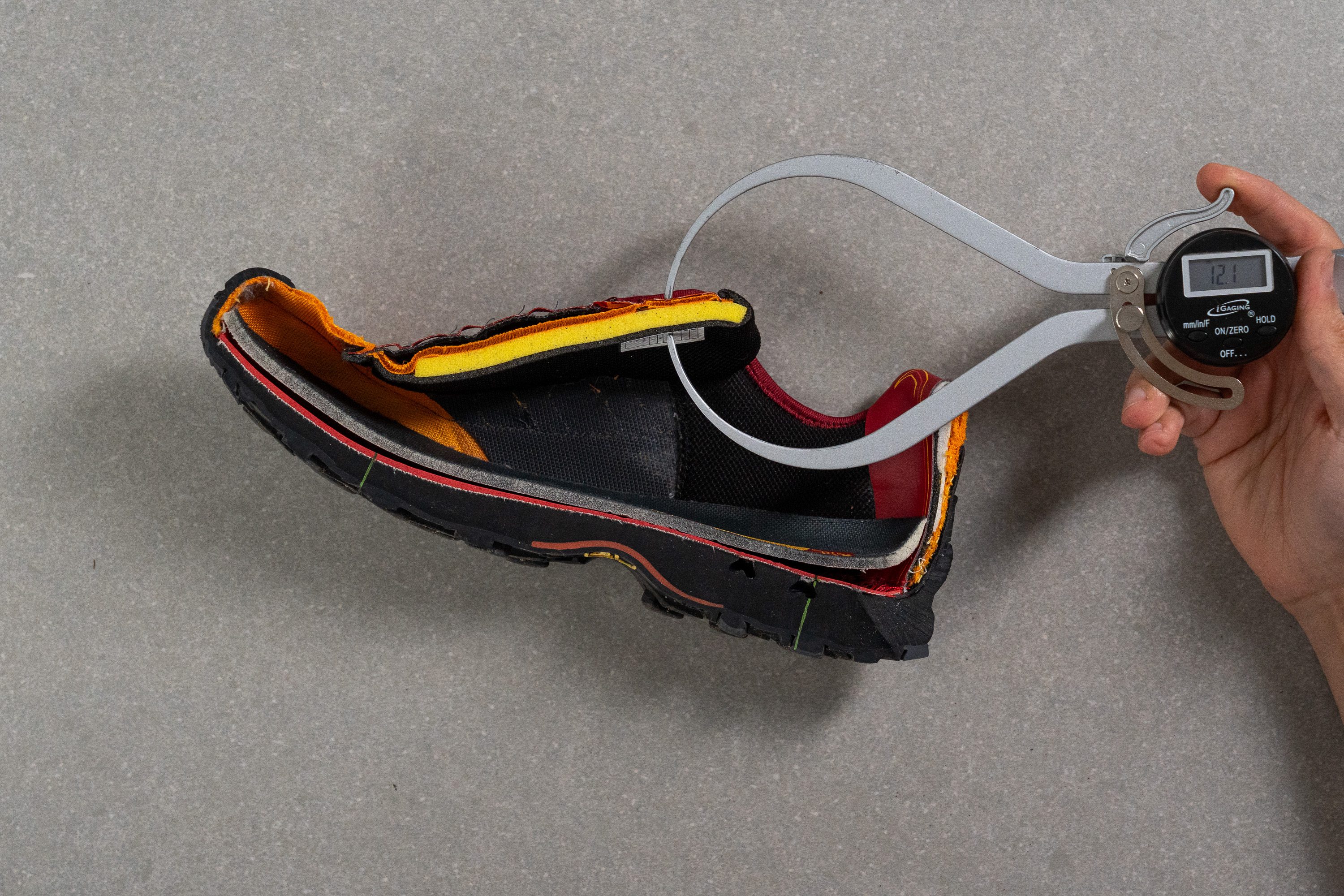
| Ultra Raptor II | 12.1 mm |
| Average | 10.2 mm |
Tongue: gusset type
Even though it's not a waterproof shoe, the Ultra Raptor II features a similar bootie design as its GTX version. The tongue is not separated from the rest of the upper and there are no gaps for pebbles and small debris to easily sneak inside the shoe.
Sure, this setup added a bit of work during the on-and-off but it made our foot feel wonderfully secure once on.
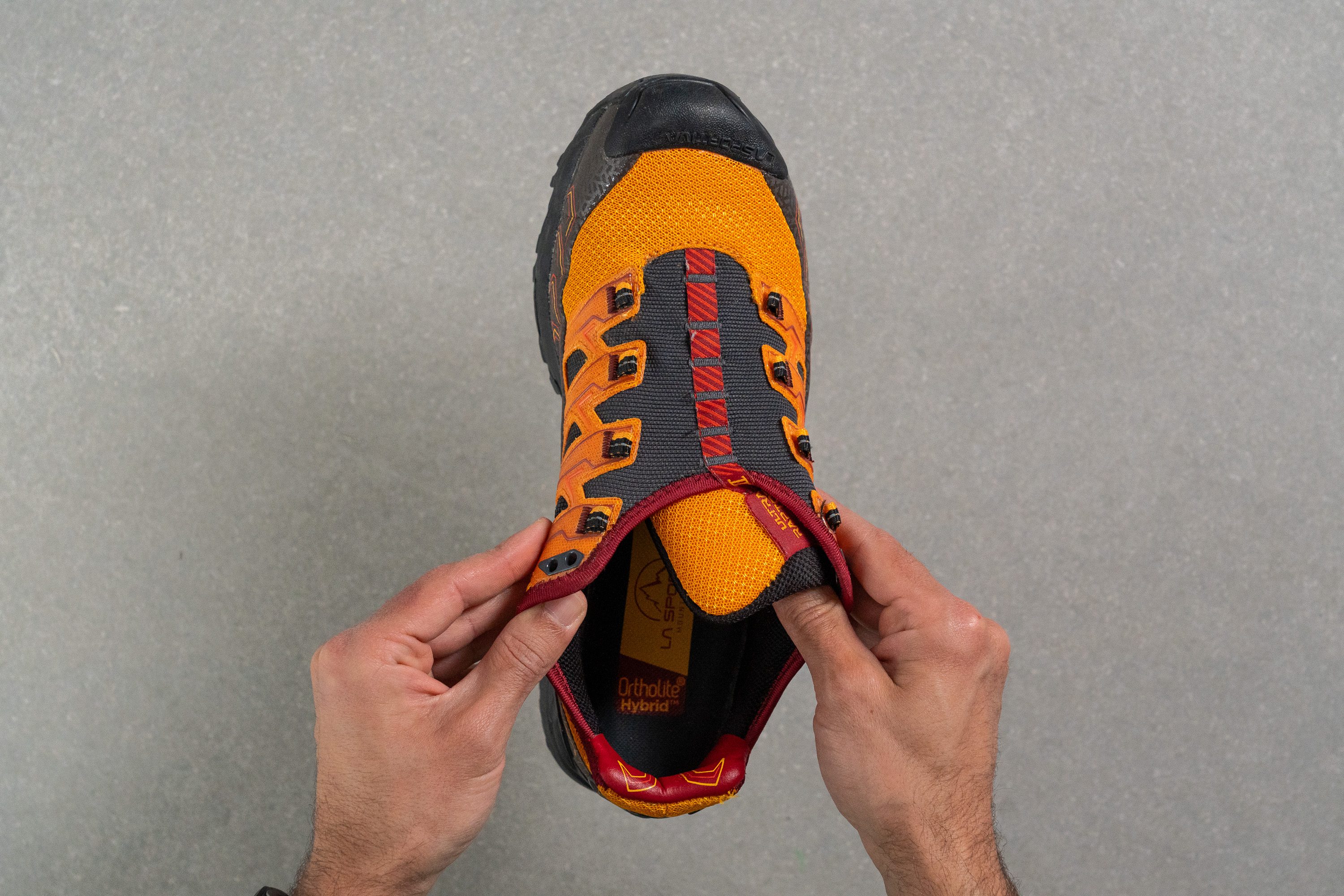
| Ultra Raptor II | Bootie |
Price
In our opinion, the asking price of this La Sportiva shoe is set too high, especially for a non-GTX shoe.
It is one of the priciest hiking shoes in our lab but we are not sure if it lives up to such a high-set bar, to be honest. Sure, it's an exceptionally well-performing alpine shoe but its lack of outsole longevity doesn't go along with the MSRP.
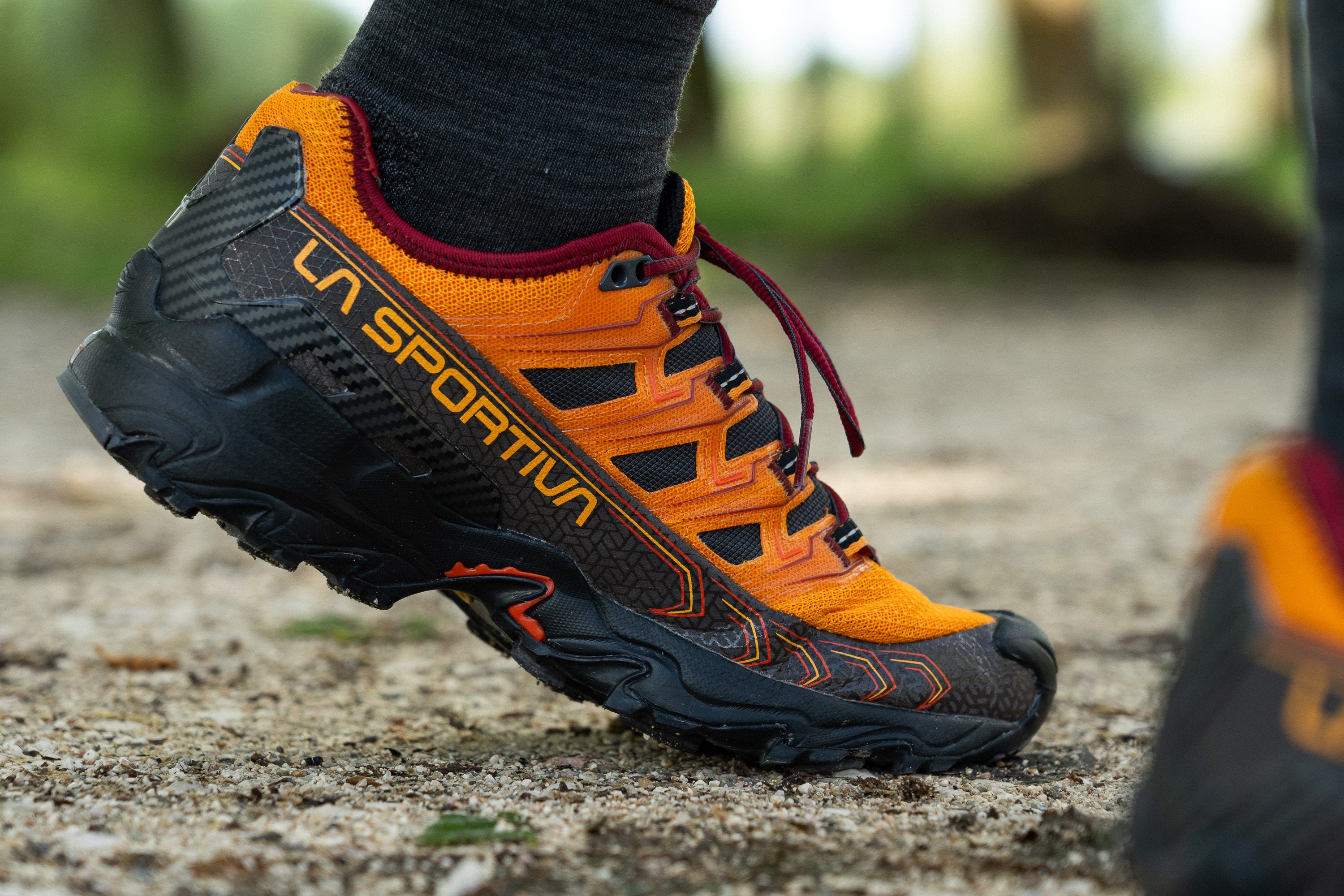
| Ultra Raptor II | $205 |
| Average | $151 |
Heel tab
Unfortunately, there is no finger loop to help in putting the shoe on either.
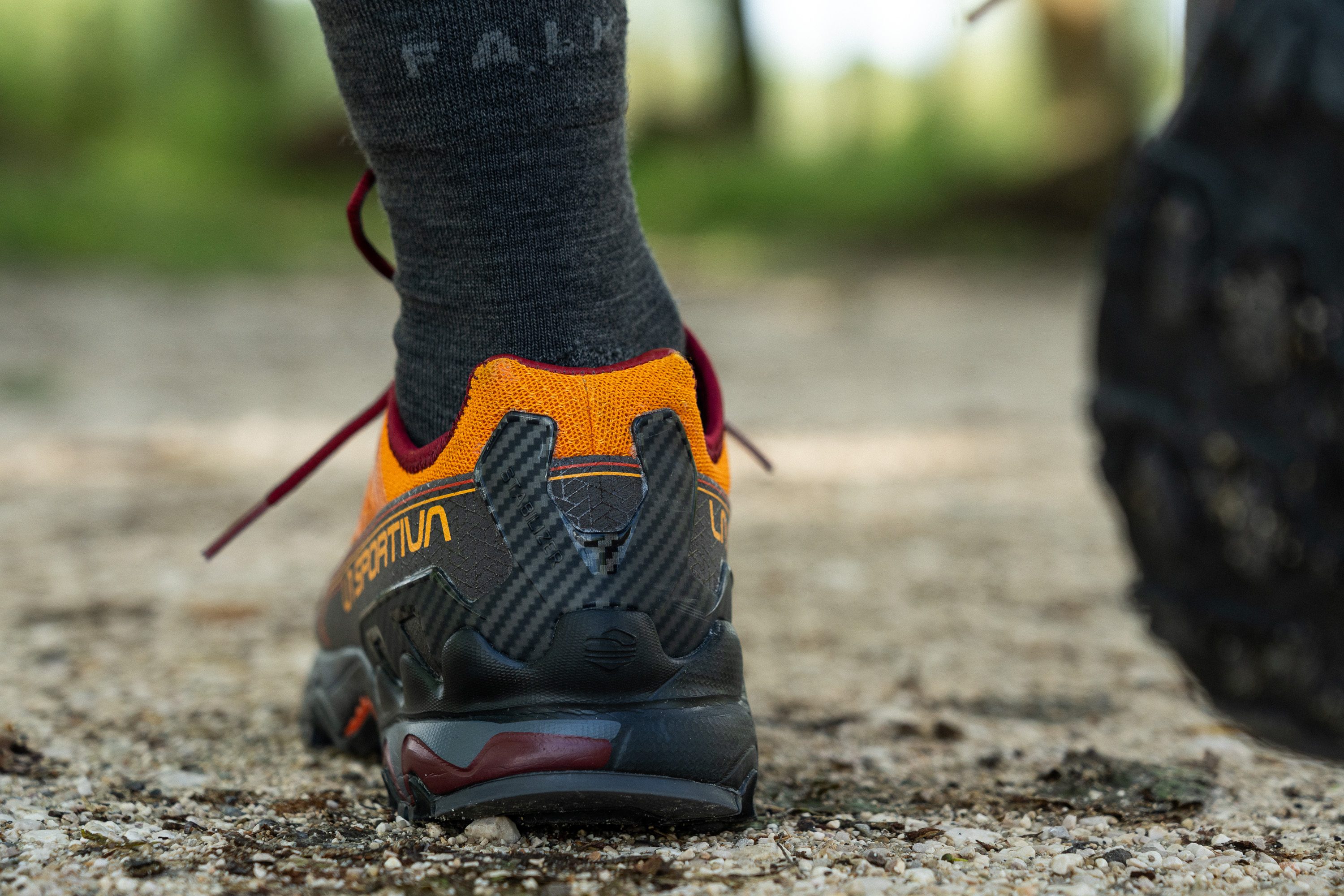
| Ultra Raptor II | None |

